From b r m ud b k s show
Tyler Odom of Your Arms Are My Cocoon has already reinvented screamo once— and he’s just ge ing started. by Leor Galil, p. 18

A land trust for Logan Square? by Joe Engleman, p. 10

From b r m ud b k s show
Tyler Odom of Your Arms Are My Cocoon has already reinvented screamo once— and he’s just ge ing started. by Leor Galil, p. 18

A land trust for Logan Square? by Joe Engleman, p. 10
04 Editor’s note The woods
06 Street View A war reenactor lurks by Joann.
07 The To-Do Black History Month
& DRINK
08 Sula | Food feature Links Taproom comes back from the dead.
&
10 Feature A northwest-side community land trust’s proposed condo development could be a model for affordable housing in Chicago.
12 Visual arts Photographer Riley Valentine’s devotion to analog
14 Plays of Note Alex Grelle returns with The Grelley Duvall Show V, plus Ghosts at Gwydion Theatre Company and Racecar Racecar Racecar at Bramble Theatre
15 Film feature Local podcast and radio show Filmspotting will celebrate its 20th anniversary with a festival.
16 Moviegoer Black cats
17 Movies of Note Bridget Jones: Mad About the Boy is let down by a straight-to-streaming release; Paddington in Peru, more spin-off than sequel, is a silly good time.
& NIGHTLIFE
18 Galil | Music feature Tyler Odom of Your Arms Are My Cocoon has already reinvented screamo once—and he’s just getting started.
20 Secret History Eighties rockers Ruffian burned bright but faded away.
22 Shows of Note Previews of concerts including Horsegirl, the Egyptian Lover, and Molchat Doma
26 Gossip Wolf International Anthem’s 11th birthday party adds a Hungry Brain residency, and veteran DJ Lee Collins needs help paying for cancer treatment. CLASSIFIEDS




(Clockwise from top)
International Anthem artists Makaya McCraven and Ben LaMar Gay CRISTINA MARX PHOTOMUSIX
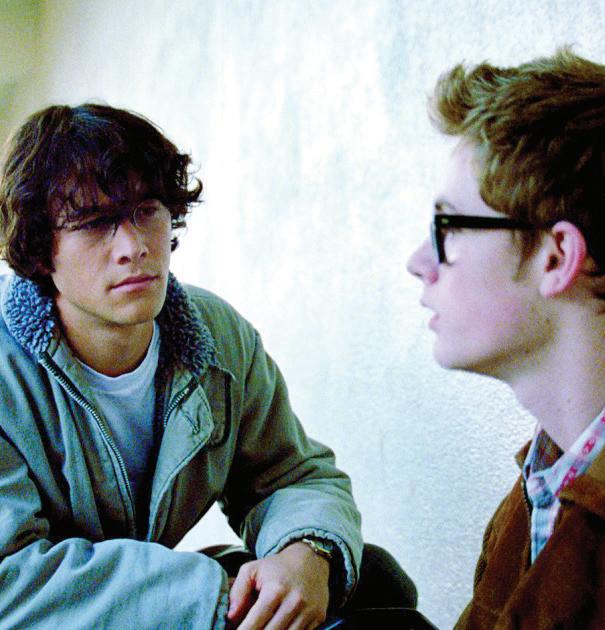
27 Savage Love Talking out your
Here to Stay, a northwest-side community land trust, plans to develop a lot on West Cortland into a sixfl at condo building SHIRA FRIEDMAN-PARKS
Still from Brick (2005) COURTESY MUSIC BOX THEATRE
From Riley Valentine’s Intravenus RILEY VALENTINE
Michael Quinlan’s beer at Hopleaf KIRK WILLIAMSON
@CHICAGOREADER.COM
PUBLISHER AMBER NETTLES
CHIEF OF STAFF ELLEN KAULIG
EDITOR IN CHIEF SALEM COLLO-JULIN
ASSISTANT MANAGING EDITOR
SAVANNAH RAY HUGUELEY
PRODUCTION MANAGER AND STAFF
PHOTOGRAPHER KIRK WILLIAMSON
SENIOR GRAPHIC DESIGNER AMBER HUFF
GRAPHIC DESIGNER AND PHOTO RESEARCHER SHIRA
FRIEDMAN-PARKS
THEATER AND DANCE EDITOR KERRY REID
MUSIC EDITOR PHILIP MONTORO
CULTURE EDITOR: FILM, MEDIA, FOOD & DRINK TARYN MCFADDEN
CULTURE EDITOR: ART, ARCHITECTURE, BOOKS KERRY
CARDOZA
NEWS EDITOR SHAWN MULCAHY
PROJECTS EDITOR JAMIE LUDWIG
DIGITAL EDITOR TYRA NICOLE TRICHE
SENIOR WRITERS LEOR GALIL, DEANNA ISAACS, BEN JORAVSKY, MIKE SULA
FEATURES WRITER KATIE PROUT
SOCIAL JUSTICE REPORTER DEVYN-MARSHALL BROWN (DMB)
STAFF WRITER MICCO CAPORALE
MULTIMEDIA CONTENT PRODUCER SHAWNEE DAY
SOCIAL MEDIA ENGAGEMENT
ASSOCIATE CHARLI RENKEN
VICE PRESIDENT OF OPERATIONS ANN SCHOLHAMER VICE PRESIDENT OF PEOPLE AND CULTURE ALIA GRAHAM
DEVELOPMENT MANAGER JOEY MANDEVILLE DATA ASSOCIATE TATIANA PEREZ
MARKETING ASSOCIATE MAJA STACHNIK
MARKETING ASSOCIATE MICHAEL THOMPSON
VICE PRESIDENT OF SALES AMY MATHENY SALES REPRESENTATIVE WILL ROGERS SALES REPRESENTATIVE KELLY BRAUN
MEDIA SALES ASSOCIATE JILLIAN MUELLER
ADVERTISING
ADS@CHICAGOREADER.COM, 312-392-2970
CREATE A CLASSIFIED AD LISTING AT CLASSIFIEDS.CHICAGOREADER.COM
DISTRIBUTION CONCERNS
DISTRIBUTIONISSUES@CHICAGOREADER.COM
READER INSTITUTE FOR COMMUNITY JOURNALISM, INC.
CHAIRPERSON EILEEN RHODES
TREASURER TIMO MARTINEZ
SECRETARY TORRENCE GARDNER
DIRECTORS MONIQUE BRINKMAN-HILL, JULIETTE BUFORD, DANIEL DEVER, MATT DOUBLEDAY, JAKE MIKVA, ROBERT REITER, MARILYNN RUBIO, CHRISTINA CRAWFORD STEED
READER (ISSN 1096-6919) IS PUBLISHED WEEKLY BY THE READER INSTITUTE FOR COMMUNITY JOURNALISM 2930 S. MICHIGAN, SUITE 102 CHICAGO, IL 60616, 312-3922934, CHICAGOREADER.COM
COPYRIGHT © 2025 CHICAGO READER ALL RIGHTS RESERVED. CHICAGO READER,

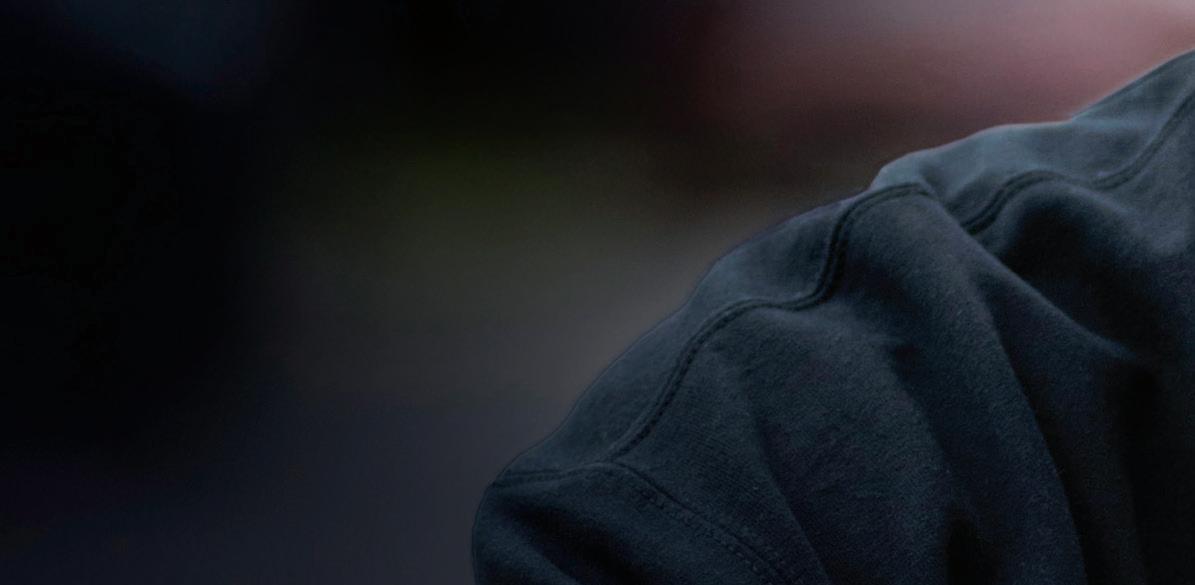























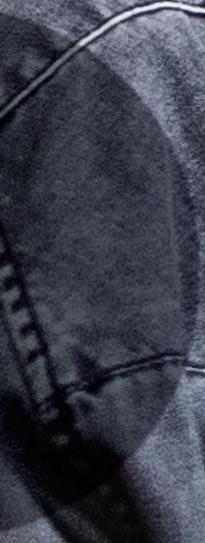

“How’s your 2025 been?” It feels both ridiculous and necessary to greet people that way this month. Frankly, I often find myself at a loss for how to ask in a way that doesn’t put more pressure on me to keep both ends of the conversation going, because I know many of us can’t easily answer that question these days. The entire world hasn’t blown up, but many of the threats we were hearing about in the latter half of 2024 have come true. The Department of Government E ciency (DOGE)—
Find us on socials:
Facebook and Bluesky: chicagoreader
X: Chicago_Reader
Instagram and Threads: chicago_reader
Linkedin: chicago-reader
The Chicago Reader accepts comments and letters to the editor of less than 400 words for publication consideration.
m letters@chicagoreader.com
people with absolutely no governmental, military, or even human resources training were allowed to make decisions about the employment of sta ers at the National Nuclear Security Administration. At the end, less than 50 workers had their jobs terminated. But those are experts with complicated government security clearances who managed our country’s nuclear stockpile, which is not the sort of job you get to have based solely on your ability to bark loudly and create dumb memes.
As of last weekend, the Department of Energy was rushing to find the workers that DOGE had fired and rehire them, but since the human resources department wasn’t clued into the process of the layo s from the get-go, it’s still a work in progress. And the Trump administration’s stance against DEI principles has resulted in maps being rewritten, online exhibitions disappearing, and even lists of documentation from the Occupational Safety and Health Administration being removed from their website.
I once met someone who worked for OSHA for over 40 years. “Keep your head down and fill out every piece of paper they give you in full,” he said when asked about his job.
How’s my 2025 been? Politically and logically challenging. I’ve had personal struggles and

shared with all of you in the global struggles. And it’s been a typical Chicago winter, which in my eyes means not enough snow (just keep it cold and dreamy, thanks).
My work has been a challenge too this year.
As you know, we at the Reader have been treading water as we continue to deal with our financial crisis.
While we can’t tell you how essential and heartwarming your response to our calls to action in January were, we still find ourselves in the continuing scramble to build a raft and stay afloat.
Donations to the Reader Institute for Community Journalism (RICJ) are tax-deductible.
And if you know someone who wants to advertise with us, so much the better. Take out a classified ad (classifieds.chicagoreader. com) or contact our advertising team at chicagoreader.com/advertise.
We’ve been able to get to this part of February, which means that we feel good about getting through March. We want to be with you for a very long time, but supporting the people who make this paper requires funding. Please donate at chicagoreader.com/donate if you believe in what we do. v
—Salem Collo-Julin, editor in chief m scollojulin@chicagoreader.com
We’ve done this work for over 53 years, and just like you, we can’t imagine a Chicago without the Reader. Right now, we need your financial help more than ever.
In 2024, we published:
46 dance reviews
311 theater reviews
202 film reviews
325 music previews
We can’t do this without you.
We’re not ready to stop this work. Chip in today. Share on social media. Donate now

Military uniforms combine functionality with timeless style. No wonder Chicagoan Anne Arundel looked so striking in her military garb while running errands at a strip mall.
Arundel is a member of the North West Territory Alliance (NWTA), an American Revolutionary War reenactment organization. NWTA strives for accuracy while recreating the culture and style of late 18th-century wartime, and Arundel’s outfit was inspired by the 71st Regiment of Foot, a British Army infantry regiment that fought in the war. The regiment—unofficially known as Fraser’s Highlanders after its first leader, Colonel Simon Fraser—consisted of a group of Scottish soldiers who sailed from Glasgow to North America to provide reinforcement for the British troops.
On the day we met, Arundel was sporting an intricate Highland coatee—a coat worn by light infantry soldiers from the Scottish Highlands during the period. Though reserved in manner, Arundel lights up when talking about
TK caption TK CREDIT

STREET VIEW
A war reenactor marches to her own tune.
By ISA GIALLORENZO
military history, music, or fashion. Despite her extensive knowledge in those subjects, her day job involves working with pharmaceutical patents, which seems to reinforce her incredible attention to detail.
“Everything about this garment has significance,” Arundel told me. “For example, you can see the button here [with the number 71 stamped on top]. The ‘one’ is reversed—on purpose. It’s because the 77th regiment consisted of spies. That’s the lore that came down to us. The ‘one’ is reversed on purpose to distinguish the 71st regiment from the 77th.”
The significance of the adornments to the uniform doesn’t stop there. “My regiment
is in the second battalion, so you can see the buttons and even the red threads in the lace on the white facings are in sets of two,” she added. “Everything is very traditional in the British Army. Whereas on the continental side, they had no uniforms [at the beginning] and rushed to obtain uniforms from France, so [they] had little decoration on them. They just wanted to get the soldiers equipped and out in the field.”
Arundel also wore a Highland diced bonnet hat and a matching pair of kilt hose. She had to rush to another kind of field that day after shopping, so she kept her outfit somewhat casual by opting for a “toy kilt” instead of the tra-

ditional version made up of nine yards of fabric.
“That’s where the phrase ‘the whole nine yards’ originates. . . . Kilts are very versatile little garments. You could even use them as tents,” she explained. In lieu of a traditional 18th-century waistcoat or straight last shoes, her Columbia Sportswear vest and John Fluevog lace-up booties carried the look from the battlefield to the sidewalk, lending Arundel an intriguing yet practical vibe.
Arundel played a fife while waiting for her shopping partner to end their special mission at Jo-Ann Fabrics. “The fife is a very high-pitched military instrument that’s supposed to be heard over cannon fire, muskets, screaming horses, and the din of battle,” she said. “Certain tunes are considered command and control of the regiment. There’s a certain tune for advancing. There’s a certain tune for a withdrawal. You play music just as much as giving commands.” A fife could come in handy to announce to your companions that it’s time to leave that sale behind. v
m letters@chicagoreader.com


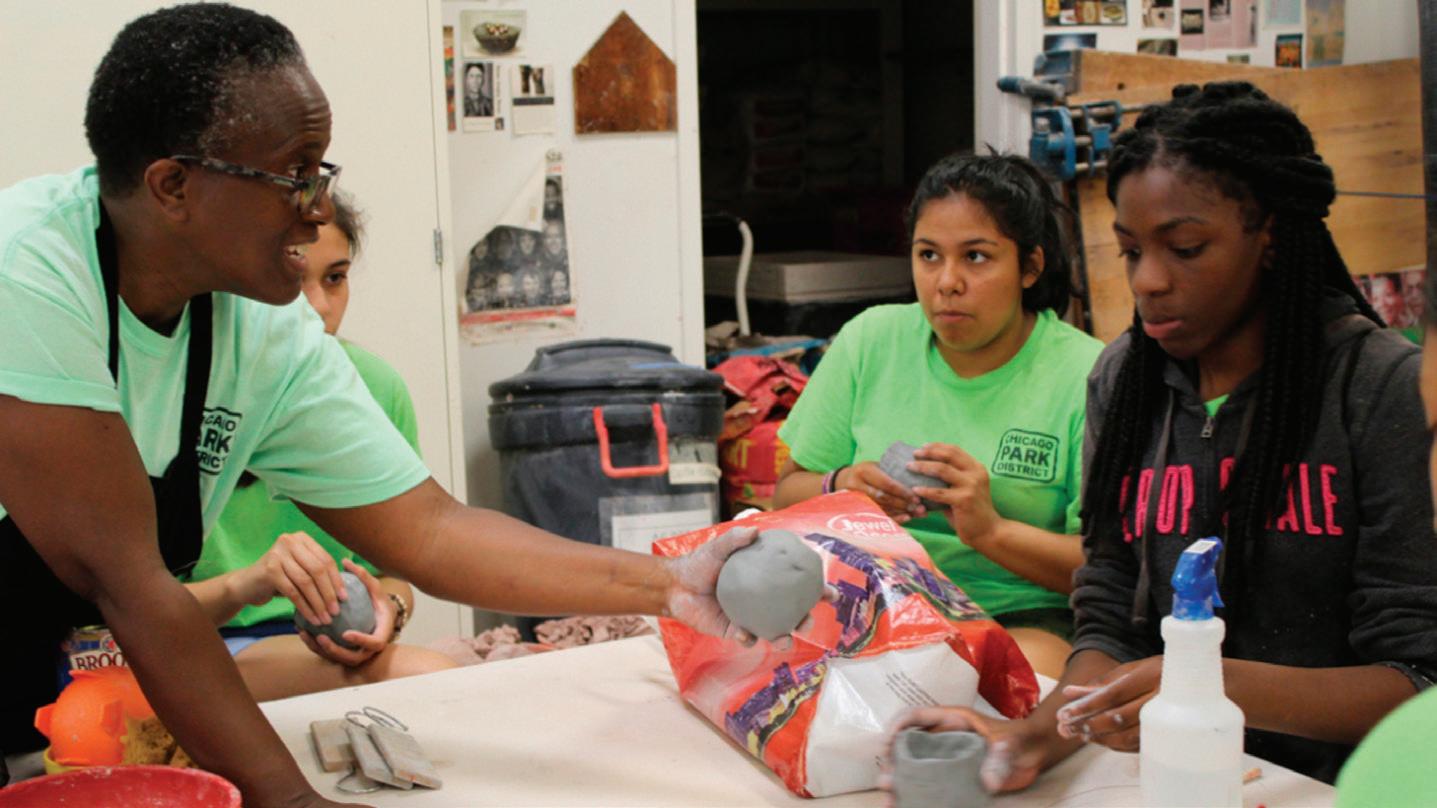



Upcoming events and activities you should know about
By SALEM COLLO-JULIN
February is Black History Month, which is a chance to honor generations of Black American achievement. Here are some pertinent events, exhibitions, and public gatherings happening in celebration of the observance.
The Chicago Park District is commemorating Black History Month with a variety of events across the city in February, including tonight’s Soul Train Black History Month celebration in Bronzeville’s Taylor Park (39 W. 47th). The classic TV dance show will serve as inspiration for a free evening of music performances. Additionally, the Umoja Black History Celebration at Homan Square Community Center Park (3559 W. Arthington) on Saturday, February 22, will include African cultural arts, dancing, and community vendors. The event is suitable for all ages and happens from 9 AM to 4 PM. A full list of Black History Month programs hosted by the Park District is viewable at chicagoparkdistrict.com/black-history-month.
The Chicago History Museum (1601 N. Clark) celebrates Black history year-round in a variety of ways, including hosting publicly accessible online exhibitions on topics such as Harold Washington’s 1983 mayoral election and the Jackson Oral History project (conducted by the Chicago Theological Seminary in 2020 to preserve stories from the civil rights movement in Chicago). Today’s Commemorative Day for Black History Month gives visitors a chance to participate in activities like printmaking (with teaching artist Jomo Cheatham) and a lecture about Emmett Till from Christopher Benson, coauthor with the late Mamie
Till-Mobley of a book about Till’s case, Death of Innocence (noon–1 PM). You’ll also be able to view current exhibitions in person, including “Designing for Chicago: Chicago Protest Art of the 1960s–70s,” which features documentation about the Organization of Black American Culture’s infamous Wall of Respect mural. Programming runs from 10 AM to 2:30 PM and is included with general admission to the museum ($17–$19, free for children 12 years old and younger). chicagohistory.org
The Social Justice Initiative (SJI) at University of Illinois Chicago (UIC) is a multidisciplinary project aimed at “furthering the production of knowledge that seeks to change the world.” SJI maintains a public exhibitions and events space called Chicago Justice Gallery near campus (1344 S. Halsted). Tonight’s Justice Lens Film Series screening at the space offers viewers two documentaries picked to compliment the gallery’s current exhibition, “Echoes of Ferguson,” which features photography that documents the complexities of Black life. The six-minute fi lm Beneath the Surface is about a data-driven investigation into how marginalized communities experience police violence and features Chicago journalist trina reynolds-tyler and her colleagues at Invisible Institute (2023, directed by Chicagoan cai thomas). And fi lmmaker Matthew Solomon’s 2023 documentary Reimagining Safety interviews experts from a variety of fields who question the idea that more police or more prisons would make humanity safer. The free 6 PM screening will be followed by a discussion with Solomon. sji.uic.edu/events v
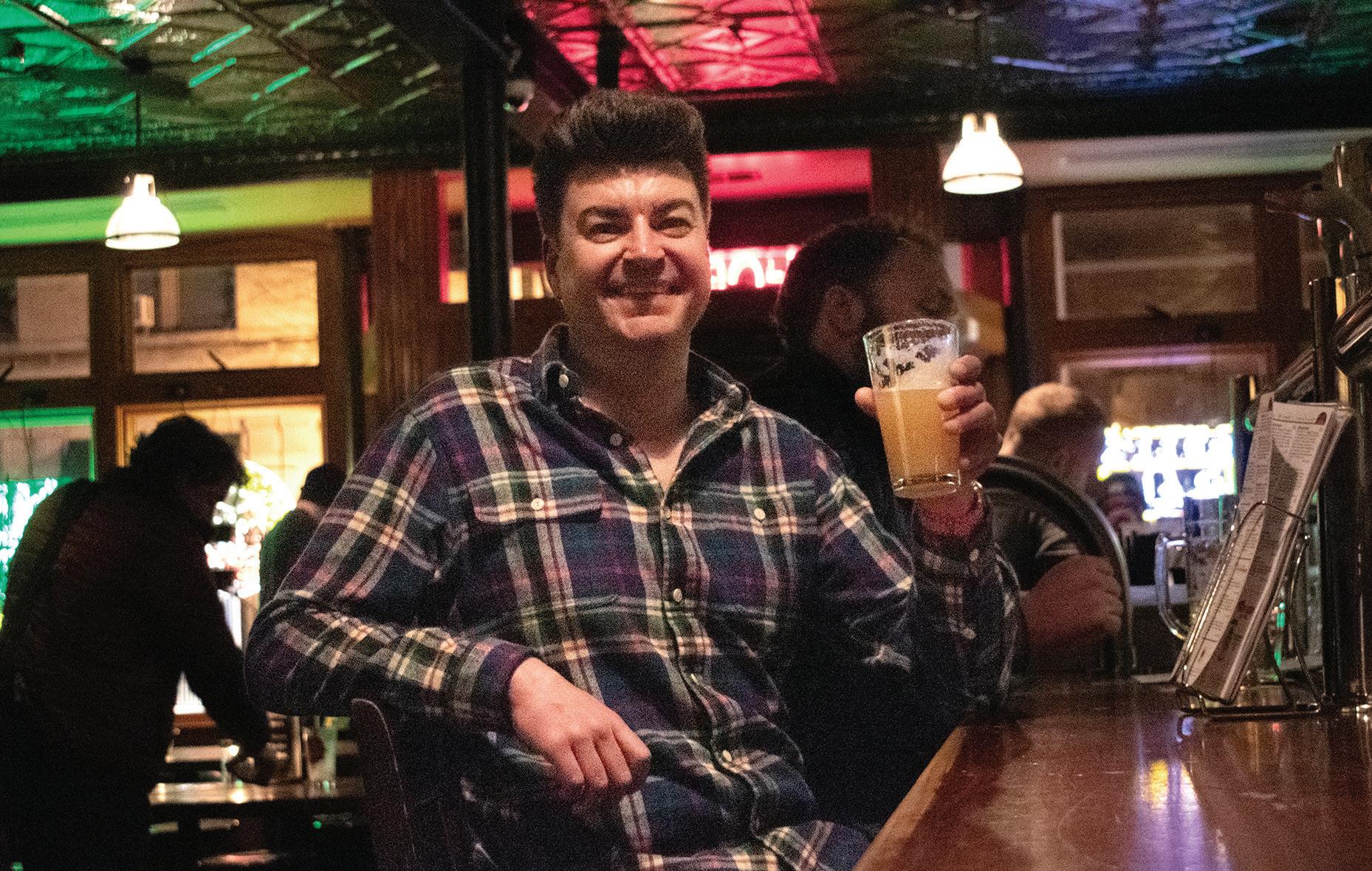
Michael Quinlan’s late Wicker Park beer bar will rise again in West Town this summer.
By MIKE SULA
Michael Quinlan and the late Michael “Bubs” Quinlan have a couple things in common besides their first and last names. The latter, a well-coifed southside Irish gangster, is identified in a 1932 press photo as a “beer runner” arrested for attempted murder.
The former Quinlan is no mobster, but is a living, breathing beer runner of sorts. And his tall, dark-brown pompadour—never a hair out of place—is occasionally shouted out in the wild by former patrons of his long-dormant beer bar, Links Taproom.
Links closed unceremoniously in March 2020, exhausted by a protracted landlord maintenance dispute and then felled by the
first COVID shutdown. Quinlan’s been trying to reopen it ever since, teasing it on social media. He came close to inking a deal that collapsed in the interim, but today he finally has an answer to the question he is asked most.
Late this summer, he’ll reopen Links Taproom and Brewery at 1725 W. Hubbard, the soon-to-be former home of On Tour Brewing Company. In its six-year lifespan, Links Taproom was beloved by a certain species of Wicker Park party animal attracted to the bar’s 36 tap lines monitored by flatscreens measuring the declining volume of each keg. It’s remembered for its relatively
ed from Fenwick High School in Oak Park. He started working in restaurants at the age of 14 (at McDonald’s) and continued working in the industry through college and beyond. He graduated with a history degree and planned to study for a PhD, but travel interfered.
“I’ve always been into craft beer, and I do love the band Phish,” he says. “So that brought me around di erent areas of the country that I wouldn’t have otherwise normally gone.”
In the Pacific Northwest, he picked up on something special. “The stark contrast in the beer scene on the west coast versus the beer scene here in Chicago in the late aughts and early 10s was that there was a lot of holier-than-thou elitism here. I was seeing how laid-back and advanced it was out there. You weren’t going to get eyes rolled at you for asking a perceived stupid question. They were genuine.”
Quinlan took inspiration from bars like since-closed Bailey’s Taproom in Portland, Oregon, where he first encountered the digital tap system he installed at Links; and Toronado in San Francisco, once adjacent to Rosamunde Sausage Grill.
“I wanted to take beer and sausage and do something very casual, very beer hall, and very west coast—and bring that to Chicago. I thought there was a need for it. I thought it would be embraced. And lo and behold, it was.”
upscale bar food (housemade sausages, handcut fries, cheese curds) but perhaps most importantly for the unpretentious vibe the audaciously punning Quinlan cultivated with friendly, expert bartenders; perpetually spinning back-bar vinyl; and no-cover-charge live webcast concerts by his favorite band, Phish. Well, that last bit could be polarizing, but all together they kept the bar bumping from day one in early 2014.
Quinlan grew up in Oak Brook but graduat-
Quinlan teamed up with former Branch 27 chef–owner Cary Michael, whom he met when both worked at Bob Chinn’s Crab House. Collaborating with local meat encaser Big Fork Brands, they designed a menu built around bespoke, housemade sausages like the three-chile chorizo and the Chicago steak and ale. There were some 16 sauces to dip your thick, hand-cut fries in—say, chile mango, stout mustard, goat cheese–garlic—but their most enduring expression, the one Links stans still talk about, were the Buried Alive fries, a shared mountain of spuds blanketed in sausage, bacon, cheddar, green onions, and giardiniera.
After Links closed, Quinlan tried to keep it alive, popping up at his other bar, Schoolyard Tavern, though that didn’t last beyond the first pandemic summer.
“We closed March 16 of 2020,” he says. “Which was the last day of business before
“The reaction, pretty much universally, has been, ‘When are you reopening Links?’ rather than, ‘We are so sad you are closed forever.’”
R
TAPROOM AND BREWERY
1725 W. Hubbard, opening date TBA instagram.com/linkstaproom
the COVID shutdown, so I feel like we really never got to say a proper goodbye. Once word started to get around, people were disappointed, but the reaction, pretty much universally, has been, ‘When are you reopening Links?’ rather than, ‘We are so sad you are closed forever.’ As far as anyone knew, the plan always has been to bring Links back, albeit at a di erent location.”
Quinlan never really stopped looking for that location. He worked on a deal for 14 months—teasing his followers with hints at a comeback—only to watch it fall apart in the final stages.
Then last spring he started talking to Mark Legenza of On Tour about building out a kitchen in the West Town brewery and installing Links there. But before long, Legenza decided to exit the business altogether, o ering to sell it to Quinlan.
There’s been a well-documented downturn in the craft beer industry in recent years. According to the New York Times , after a long period of explosive growth, the overall number of American craft breweries declined in 2024, with 339 closings, compared to 335 openings.
On the other hand, a turnkey operation can represent a valuable opportunity in the business. Quinlan plans to revive Links much as it was during its heyday, from the digital tap lines to the cheese curds to some of the sta : He’s brought
on former general manager Ryan Mandernach as operating partner.
One key difference is that for the first time, he’s interviewing brewers to scale up the brewery’s five thousand barrels per year capacity. Brewing beer was “not something I had planned on,” he says. “But I’m pretty darn confident in the Links Taproom brand. The brewery aspect of this is going to be an enhancement to that. So, at the old Links, I had 36 handles, all American craft. The way I see things now, I’ll have, let’s say, 42 handles, and six of those will be coming out of our tanks.”
Another new feature will be that photo of beer runner Michael “Bubs” Quinlan. “I definitely plan on hanging that on the wall.”
He’s hoping for a late summer opening for Links Taproom and Brewery, but he’s also realistic about the inevitable delays that go hand in hand with restaurant and bar openings in Chicago. So to appease the fans that have been freaking out over his recent cryptic social media teases, Links will come alive briefly on May 19 at Monday Night Foodball, the Reader’s weekly chef pop-up at Frank and Mary’s Tavern in Avondale.
More on that later, but at the very least, he’ll be bringing Buried Alive fries back from the dead. v
Michael Quinlan plans to revive Links much as it was during its heyday.





m msula@ chicagoreader. com
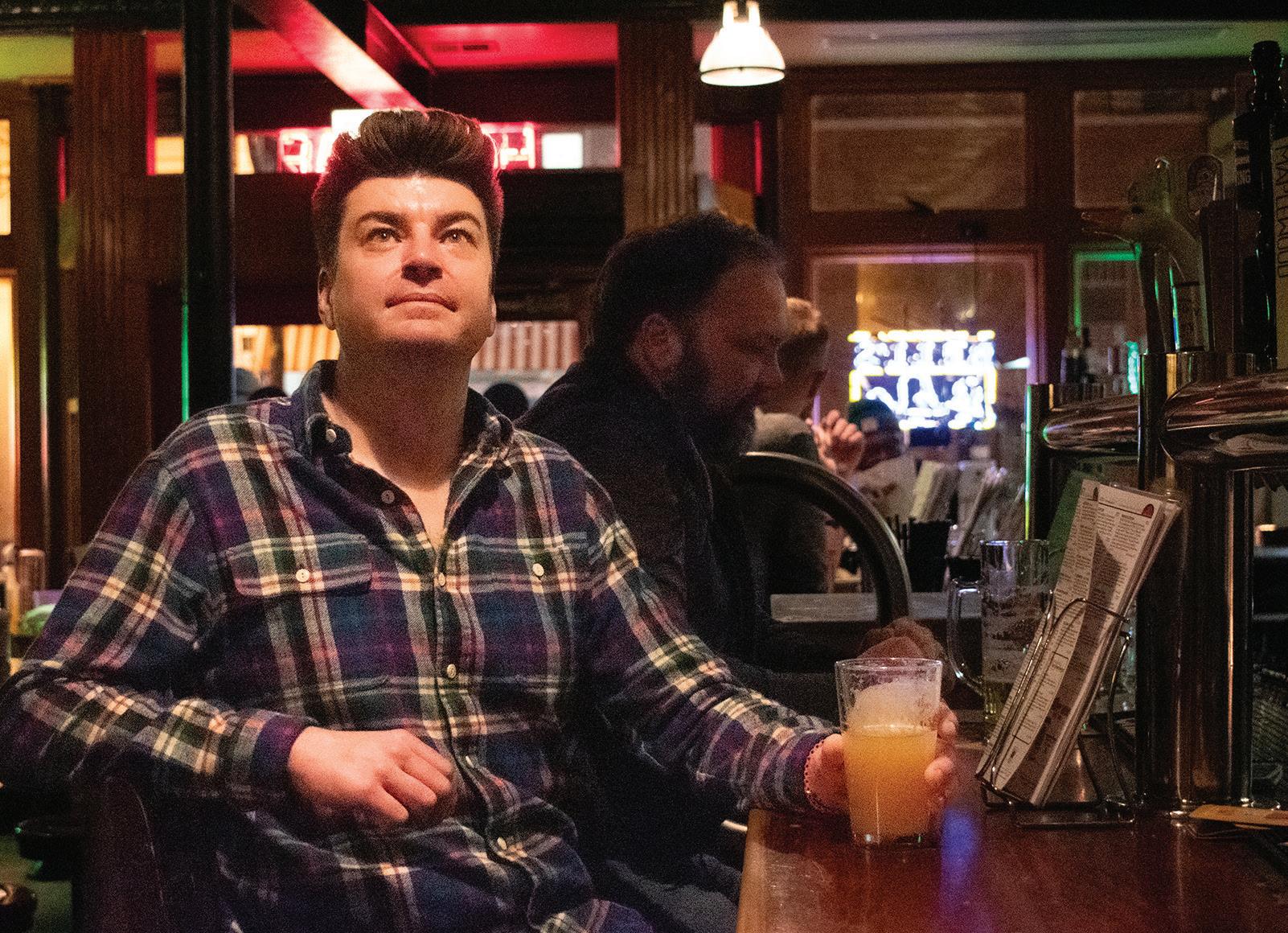






AN UMAMICUE BENEFIT FOR THE CHICAGO READER








FEATURING A LOW-AND-SLOW BBQ PLATTER: SMOKED BRISKET PULLED PORK CHAR SIU RIBS SESAME NOODLES SMASH CUCUMBERS WHITE RICE
Fri., Feb. 21 • 5 PM FRANK AND MARY’S TAVERN
2905 N. Elston
$35 Preorder via Tock

Could a northwest-side community land trust’s six-flat condo development be a model for affordable housing?
By JOE ENGLEMAN
In late 2024, a developer presented plans for a vacant lot on the 2600 block of West Cortland Street at a monthly zoning meeting held by First Ward alder Daniel La Spata. The group behind the proposed three-story, six-unit, all-electric building isn’t a giant for-profit firm like Sterling Bay, a longtime affordable housing developer like Bickerdike, or any one of the small and midsize developers that fly under the radar until they bring the urban growth machine to your block.
The developer is the Here to Stay community land trust, an organization founded in 2019 by a group of northwest-side nonprofit housing organizations (Palenque LSNA, Center for Changing Lives, Latin United Community Housing Association, and the Spanish Coalition for Housing) to prevent displacement in Avondale, Hermosa, Humboldt Park, and Logan Square. Where traditional affordable housing developers can provide a ordability for 30 years with support from federal tax credits, a community land trust seeks to decommodify land altogether. A land trust “has the capacity to remove real estate from the speculative market, making it permanently a ordable and accessible for long-term community benefits,” says Mia Carbajal, Here to Stay’s director of special projects. “As things get more expensive and markets price communities out,” community land trusts are a way to ensure that housing and community

spaces can remain a ordable and accessible “in perpetuity.”
The model is thought to have emerged in the rural south in the late 1960s, when civil rights organizers in Georgia formed New Communities Inc. They were inspired by a long history of Black cooperatives, indigenous land stewardship practices, India’s Gramdan movement, and an Israeli Labor Zionist model of cooperative land ownership. Today, you can find residential and commercial community land trusts across the country, developing new properties and rehabbing existing ones.
This model isn’t novel for Chicago-area housing. The City of Highland Park launched Community Partners for A ordable Housing in 2003, which has nearly 100 properties in a land trust that covers Evanston, Lake Forest, Highwood, and Highland Park. In Chicago, Albany Park–based Centro Autónomo founded the Casas del Pueblo community land trust in the aftermath of the housing foreclosure crisis in the late 2000s and housed 70 families by 2013.
It’s safe to say that preserving a ordability is close to home for Here to Stay. Achieving that goal requires many di erent tactics and tools. The organization’s approach specifically focuses on affordable homeownership. After meeting the qualifications, including
being a first-time homebuyer and making 120 percent or less of the Chicago metro’s area median income (around $107,640 for a couple, $121,080 for a family of three), Here to Stay’s selected applicants sign a 99-year renewable ground lease which includes a resale formula to ensure that the property remains a ordable while allowing the homeowner to build some equity from a sale should they decide to move.
Here to Stay’s Cortland proposal is what’s often called “missing middle” housing: small-scale multifamily housing like the twoand three-story buildings on many Chicago residential blocks. “If this is not the kind of development we want to be encouraging in the city of Chicago, I don’t know what is,” La Spata says.
Given mortgage interest rates, purchasing even subsidized homes often requires two incomes, which makes condo units more a ordable than the typical single-family home in Here to Stay’s portfolio. “Condo construction is all new to us,” says Lucy Gomez-Feliciano, Here to Stay’s community engagement director. “We’re trying to meet people where they’re at. We’re not gonna meet everybody’s needs, but this is another way to provide affordable homeownership.”
The development project may also have
implications for the emerging ecosystem of land trusts, worker cooperatives, limitedequity housing cooperatives, and communityinvestment vehicles seeded by a city-funded community wealth-building program that began under Mayor Lori Lightfoot’s administration and is now housed at the University of Illinois Chicago. The Englewood Community Land Trust recently acquired property on South Loomis Boulevard, and Blacks in Green and the Street Vendors Association of Chicago are preparing initiatives in West Woodlawn and North Lawndale, respectively. In addition to the city-seeded programs, Austin Coming Together is holding information sessions as it prepares to launch a land trust on the west side. While each emerging land trust is operating in different neighborhoods with di erent sponsors, the successful construction of Here to Stay’s Cortland condos will further demonstrate the local feasibility and cost-effectiveness of land trusts pursuing development. However, when you try to build housing that would be a ordable to many Chicagoans, nightmarish challenges tend to seek you out. Here to Stay’s financial plan for the Cortland development appeared to be in good shape thanks, in part, to $1 million in federal funding. Here to Stay originally applied for $330,000,
says program director Kristin Horne, but U.S. representative Delia Ramirez, who has deep ties to e orts to preserve a ordable housing on the northwest side, pushed for more. The funding made it through the oft-fraught congressional appropriation process, but soon there was another issue. Here to Stay had originally planned to spend the funds across several single-family homes and two-flats. However, the organization had difficulties reconciling federal requirements for property owners with the land trust’s reality: The next acquisition doesn’t always crop up long in advance. Developing a ordable housing is a “puzzle,” Horne says, where you often have to “fit your square peg in the round hole.” Here to Stay decided to spend all the money in one place: a donated square lot on the 2600 block of Cortland.
When we spoke just a few days before the new administration was inaugurated, Here to Stay still had not received any federal funds or even the “full funding grant agreement” (essentially the contractual obligation that the funds would be delivered) from the U.S. Department of Housing and Urban Development. Now, Here to Stay, like so many others, has been caught up in the new administration’s hijacking of federal funds. “Innovative programs like Here to Stay ensure families can set roots in a ordable homes without the fear of displacement,” Ramirez writes in a statement. “The actions of the Administration had made it clear that all federal funding is at risk. We have heard from many of our grantees that the agencies have stopped communicating with them. The federal government must honor its commitments and fund projects that have been appropriated to our communities.”
Despite the uncertainty, Here to Stay is

moving forward with its first multifamily newconstruction development. The land trust plans to apply for the city’s share of a unique state tax credit in addition to grants and lending support. Here to Stay is also planning to turn to the city’s philanthropic community in earnest this year. It’ll be prepared to explain what land trusts are and point to its portfolio, and it’ll bring along a report from the DePaul Institute for Housing Studies and a state task force that identifies consistent funding as the biggest barrier to the future success of land trusts. “We can do the work. We can navigate all the bureaucratic channels and processes, zoning—all that comes with the territory. But we need the funds to do that,” Horne says. Here to Stay already has some future development sites in mind, including city-owned lots in Alder Jessie Fuentes’s 26th Ward. Even in this environment, the ecosystem of cooperative and community wealth-building entities is taking root, and it has the potential to be mutually reinforcing—particularly if it’s bolstered by unrestricted philanthropy, local funding, and policy support. Community land trusts play nice with limited- and sharedequity cooperatives, and there may be chances for future collaboration thanks to community wealth building, new funding sources, and the pilot programs allowing tenants to buy their buildings if they go up for sale near the Obama Center in Woodlawn and on the northwest side near the 606. Another program, the city’s social housing revolving fund, will reportedly take shape this year.
Chicagoans embracing community land trusts and cooperative entities is also key, though. My heart sinks when I see “upzone everything/build more housing” organizations detail the years of public meetings, calls, and emails spent lobbying an alder to approve a single private, for-profit development in Lincoln Park or Old Town. Just imagine the city we might have if more people brought even a fraction of that time, energy, and organizing to community-oriented ownership and development models that prevent displacement and o er permanent affordability. Some people will reject that because, to them, building housing is not about extending a human right—it’s about extraction, growth, profit, and maximalist accumulation. But for others, community, place, and home have a deeper, priceless meaning.
We’ll see which one is here to stay. v
m letters@chicagoreader.com
You cant take what you aint make I escape without a scratch.
On the surface its worthless
To be caught without them stacks Green, cheddar, mozzarella.
Momma I need a sweater
Weathering this weather, aint got better, yet I need some leather & twin propellers for my aviators
Shade the latter with dark tint.
mint condition intuitions is how I play my position
Switching seats, when my itinerary said on thing one thing & I wasnt listening
Too busy giving directions.
In my last life I was a navigator
So I’ll humble myself for your concern.
You been looking for the right way so long
You never learned, the wrong way look good.
Thats why we dont own shh in our own hood.
My brother locked up more than he free
Selling the same drugs police giving to me.
By Frsh Waters
Frsh Waters from Chicago’s Westside is a writer, performance artist, & community outreach coordinator for Chicago youth arts non-profit John Walt Foundation and is a Co-Founder of Chicago’s incomparable Pivot Gang. He believes writing is a road map to the world. Frsh is a street food lover & appreciator of art. His mantra is “Change is the crossroads to innovation; either be the change you want to see envisioned on a canvas, or wonder why it doesn’t exist.”
Opening Hours
Wednesday, Friday, Saturday: 11:00 AM–5:00 PM Thursday: 11:00 AM–6:00 PM
Archive(s) of Style
In honor of Audre Lorde’s birthday (February 18) and Black History Month, celebrate an intergenerational lineage of “glocal” (global + local) Black queer feminist poets: Cheryl Clarke, Harmony Holiday, Natalia Molebatsi, and Nikki Patin. February 27, 2025 at 6:00 PM CT
Like a Hammer: Poets on Mass Incarceration
Celebrate the release of Like a Hammer: Poets on Mass Incarceration, Haymarket Books’ anthology of writers speaking on the United States prison-industrial complex. Editor Diana Marie Delgado and contributors
John Murillo, Nicole Sealey, Keeanga-Yamahtta Taylor, and Candace Williams will read from the anthology, followed by a reception.
March 6, 2025 at 6:00 PM CT
Learn more at PoetryFoundation.org




R“INTRAVENUS: A SLIDE SHOW”
Through 2/28 : Sun 2/23 and Wed 2/26 3 –7 PM, closing reception Fri 2/28 6 –10 PM, Space.01, 2334 N. Milwaukee, rileyvalentine.net

Riley Valentine’s analog-centric solo show is an ode to the divine feminine.
By SHIRA FRIEDMAN-PARKS
Riley Valentine’s “Intravenus” is a love letter to analog. A slideshow in every sense of the word, the exhibition features 12 scenes, 27 subjects, 600 feet of Super 8 footage, four VHS tapes, 450 35-millimeter slides, and 75 Polaroids, all shot by Valentine between 2021 and 2023 and dedicated to the concept of the divine feminine.
Thirty-five prints line the room. Four stacked cube televisions play the same tape in split sequence, emulating a film strip. Other slides are projected onto screens or accessible through a tabletop slide viewer. Valentine, a Reader contributor, works exclusively with analog photography—no digital manipulation; as such, she doesn’t plan to post much of this work online.
Valentine and curator Isabella Rinald enact a conversation between extravagant portraits (with subjects styled in PVC, leather, and lace) and hyperfeminine landscapes (an array of pink neon signs, a flock of swan boats). The star of the show is a 30 x 30-inch light box
filled with around 12,000 individual Super 8 frames, in miniscule, hand-spliced filmstrips. Visitors can view the contents of the light box through two magnifying glasses hanging from the wall—the only way the filmstrips become discernible.
Valentine and Rinald discovered each other’s work online and have been pen pals ever since. Bonding over shared life experiences, artistic directions, and a love for Nan Goldin’s The Ballad of Sexual Dependency, Rinald flew in from Seattle to collaborate on “Intravenus.” I sat down with them to discuss their process and inspirations for the show.
Shira Friedman-Parks: What is the divine feminine? How would you describe it?
Riley Valentine: I don’t like to put a blanket definition on it, because it’s very expansive. The essence is femininity, rage, and resilience. I like to highlight and explore people within facets
of femininity that aren’t often brought into the conversation, such as sex workers and queers. Most of the people in this project aren’t cis.
Isabella Rinald: Femininity is a universal experience that defies gender in a lot of ways. Femininity is a perpetual sense that can exist within anybody: saccharine, tender, frivolous, defiant, erotic, debaucherous, hard as nails.
This is three years of work. How has your relationship to the divine feminine developed over time?
Valentine: I created this work from 2021 to 2023, and during the process, Roe v. Wade got overturned and [then] Donald Trump was reelected. I couldn’t create this work now. I’ve become a lot more calloused in my work. It’s important for me to revisit this, to celebrate it, and to put it to bed. It’s my last hurrah of mindless indulgence.
Rinald: Riley and I have similar backgrounds and experience in sex work, and the conversations perpetual within. Gluttonous displays of femininity such as this have had issues being platformed within the artistic community, pre- Roe and post- Roe , pre-Trump and postTrump. We wanted to make sure that this was displayed as cleanly and clearly as possible, so people could visualize what’s at stake.
How do queer and leather culture inform your work?
Valentine: They’re big parts of my work because they’re big parts of my identity. I was 19 when I started creating this work. I was exploring myself and becoming involved in these communities. That informed my creative decisions.
Your styling is elaborate, with bold makeup and costuming. How much of this is a collaboration? How much is your singular vision?
Valentine: Celebrating the model is forefront: who they are, their own feminine expression. However, I’m curating and creating the work and setting it all up. Styling is one of my favorite parts. It’s a lot of collecting and a lot of borrowing. I’ve been collecting costumes since I was 17.

I have huge bins at my house. A lot of the styling is done on set, day-of. I bring a bunch of garments; the model brings a bunch of garments.
What draws you to lm speci cally?
Valentine: I’ve been working exclusively with analog since I started photography at 16. It’s always been analog. My goal with this show was to push the boundaries of what I could do and the ways I could display directly from analog. A lot of this show, intentionally, is light, slide, and a mirror. No digital manipulation, no scanning, besides the prints. I don’t plan to show this work much online.
Rinald: Analog photography is a performative medium. It has a physicality that is innately built through work and has an imminent time. You have control of every ability you can have to take up space. You’re maximizing the ability of physical conversation. Forcing people to look. That’s impossible in a lot of digital mediums, to have physical control from step one to step one hundred.
Which part of the slideshow was your favorite to do?
Valentine: My favorite and my least favorite was the 30 x 30-inch light box. That was the

biggest pain in the ass of my life. I spent at least 70 hours just aligning them straight, hand-splicing, and taping them back together. I was hunched over in my studio for many overnights. There would be three, four days at a time where I wouldn’t sleep. I would jack myself up on Red Bull and do it until my eyes wouldn’t focus on it anymore, and then sleep for 30 minutes and get back to it. That’s my favorite and my least favorite piece I’ve ever made.
Would you consider the light box to be a literal manifestation of the gaze?
Rinald: The gaze is a really complex conversation, the male gaze, female gaze, yada yada yada. Riley explores possibilities of the gaze, possibilities of how to maximize the gaze and minimize the gaze. It is not only about politics, but about the medium itself, the love language of the medium.
Valentine: It’s important to see this work with a light heart. It’s important to not put this work in a box of sociological terms. Girls are allowed to have fun. Girls are allowed to create. I’m allowed to create work because I want to put 25 of my friends in pink body paint and celebrate them. v
m sfriedman-parks@chicagoreader.com












Sins of the father
Gwydion Theatre Company revives Ibsen’s Ghosts
Henrik Ibsen’s Ghosts had its world premiere in Chicago in 1882—a single performance in Danish at the old Aurora Turner Hall on North Clark. (That production itself forms the background for David Grimm’s 2018 play Ibsen in Chicago, which premiered at Seattle Rep under the direction of Braden Abraham, now the artistic director for Writers Theatre.) Gwydion Theatre Company’s current revival, directed by Jimmy Piraino, comes in at a tidy 90 minutes. And while the play’s allusions to syphilis no longer shock as they did 143 years ago, there are still hints (or ghosts, if you will) of how societal norms and the hypocrisies they
require infect generation a er generation.
Helen Alving (Jeanne Scurek), the widow of a sea captain, is opening an orphanage with the money her late husband le . Her son, Oswald (Tommy Thams), a painter who has just returned from Paris, is weakened by some mysterious condition soon revealed to be congenital syphilis from his hedonistic father. The family maid, Regina (Ellie Thomson), also turns out to be the product of the late Captain Alving’s philanderings, which makes the mutual attraction she and Oswald have for each other . . . awkward, and also throws her relationship with the man she’s known as her father, the scheming Jacob Engstrand (Stephen Fedo), into complication. Passing insufferable judgment on it all is Pastor Manders (Phil Aman), who urged the young Helen to return to her husband early in their marriage.
It’s Manders’s need to control Helen and her family that resonates most closely today—he talks

about Helen’s “pestilent spirit of self-will” as if he were writing an early dra of Project 2025’s views on family life. But despite flashes of relevance, this production feels a little gray and stodgy from time to time, with the actors at the performance I attended occasionally being a little inaudible or not feeling fully connected to the text. But Thams’s Oswald stands out as a (literally) febrile and anguished young man who wonders how much of the pain he’s in is from his own choices, or those passed down to him. A portrait of the late Captain Alving (created by Maddy Asma) hangs in the house. It’s simply a white silhouette of a head on a black background—a stark but resonant embodiment of an absent presence that still has power to dominate the lives of others.
—KERRY REID GHOSTS Through 3/9: Thu–Sat 7:30 PM, Sun 2:30 PM; Greenhouse Theater Center, 2257 N. Lincoln, 773-404-7336, gwydiontheatre.org, $36
Alex Grelle is back just in time for these dark days.
There’s nothing overtly political in Alex Grelle’s latest extravaganza, The Grelley Duvall Show V, even though the creator and star shouts out early on, “Where are my gays at?” But the spirit of subversion, exuberance, passion, and obsession that’s guided his earlier shows (the David Bowie–inspired Floor Show and Lady Di) is very much present in this incarnation. And it feels very much needed in these downhearted times. Yes, as the title implies, the late great Shelley Duvall shows up as both the long-suffering wife from The Shining and as the host of Faerie Tale Theatre appropriate, since Duvall, like Grelle, was a performer who was both indelible and hard to categorize.
Under the nimble music direction of Aunt Kelly, the four-piece band helps Grelle and his five supporting players embody 80s and 90s pop songs like Wham!’s “Battlestations” and Madonna’s “Bedtime Story.” (“Today’s the last day that I’m using words / They’ve gone out, lost their meaning.”) But this isn’t about mimicry as much as it is about creating an environment where we can derive meaning from the mishmash of pop culture and more highbrow art. Larry Rivers gets a shout-out, and there’s a ridiculously funny black-andwhite faux-documentary video homage to John Cage and Merce Cunningham, where Grelle’s choreographer puts his dancers through seemingly incomprehensible directions. It’s not taking lazy potshots at Cunningham, but rather showing how hard it can be to translate and imprint one’s vision onto the bodies of others.
In the second half, there’s also what feels like a send-up of any number of plays where a comfortably upper-middle-class couple confronts each other. Grelle’s cheating wife at one point strips down to reveal a generous merkin (which the performer hands off to someone in the audience). But even here, the crassness of the moment is rooted in something other than a cheap visual gag. (Not that I have anything against those!) The anguish of Grelle’s gilded-cage wife feels palpable.
As does the love Grelle has for his dad when he closes out with a leave-it-all-on-the-stage rendition of Bruce Springsteen’s “Backstreets” as a tribute to his father’s favorite song. Blending irony and earnestness is a tough challenge. But The Grelley Duvall Show V delivers, raising the low roof of the Chopin studio with glee, heart, and soul. —KERRY REID THE GRELLEY DUVALL SHOW V Through 3/9: Thu–Sat 9 PM, Sun 7 PM; also Mon 3/3 7 PM; Chopin Theatre, 1543 W. Division, chopintheatre.com, $25-$35

A father-daughter road trip reveals dysfunction in Bramble’s Racecar Racecar Racecar
What could be sweeter than a dad and daughter cross-country road trip? In Bramble Theatre Company’s Racecar Racecar Racecar (by playwright Kallan Dana, directed by Spencer Huffman) the father (Christopher Meister) is eager to share fond memories of his daughter’s early days and demonstrate his worth as a dad. The daughter (Haley Bolithon) is also eager, desperate to feel the love of a parental figure, oblivious to the reality of abuse and neglect a er a lifetime of gaslighting. It doesn’t take long for the veneer to crack as toxic behaviors and addiction show their ugly repercussions in this story of a dysfunctional family.
Overlapping scenes unwind in a disjointed, frenetic way. Maybe the nonlinear storytelling is there to underscore the point. With jumbled-up actions, the symbolism is nebulous, the motions raw and strippeddown, intended to convey visceral trauma experienced by our heroine, or at least the angst that emerges with it.
The codependent family dynamic and the daughter’s (at first) naive and hopeful delivery bring bursts of laughter and sometimes knowing groans from the audience as the true extent of her tragedy reveals itself. I busied myself trying to read feelings the protagonist dared not express through her micro-expressions, longing for one poignant standstill, traffic-jam moment to provide a peek into her character beyond her confusion and people-pleasing.
The devices (fast pacing, chaos, conflict, danger, uncertainty) meant to acclimatize us to her world sometimes alienated me to the point of disassociation. With scenes rolling in like unpredictable waves, I still struggled to recover from each previous blindsiding revelation.
Fortunately, palindromes were there to save the day—clever word games that anchor to the geography, plot, and father–daughter interactions, proving even dads with addiction and neglected children will strive for a connection. That’s the heartbreaking thing about it all. Maybe we aren’t meant to know what the road trip means to our protagonist exactly, but to feel the tragedy inherent in that missed opportunity to connect, leaving us flapping in the wind as well. —KIMZYN CAMPBELL RACECAR RACECAR RACECAR Through 2/23: Wed–Sat 7:30 PM, Sun 2 PM; mask-required performance Thu 2/20, student night Fri 2/21 (free pizza and postshow discussion); Bramble Arts Loft, 5545 N. Clark, brambletheatre.org/racecar, $25 ($35 reserved, $15 veterans, students, and seniors; limited $5 access tickets available) v
Fri 2/28 –Sun 3/2 , Music Box Theatre, 3733 N. Southport, Gene Siskel Film Center, 164 N. State, $18 –$20 per day, filmspotting.net/events/filmspottingfest
Fifty years ago, Gene Siskel and Roger Ebert, the respective film critics for the Tribune and the Sun-Times, began appearing monthly on Chicago’s PBS station WTTW in a show best known as Sneak Previews to talk about their agreements and disagreements about upcoming films. A few years later, the show was switched to biweekly and syndicated nationally, and by 1980, it was released weekly for an audience that made it one of the most-watched shows in the country. After years working on several variously named programs together, Ebert continued his work even after Siskel’s death in 1999, selecting fellow Sun-Times critic Richard Roeper as cohost of At the Movies. Following in their footsteps, this year, local film critics Josh Larsen and Adam Kempenaar will mark the 20th anniversary of Filmspotting, their weekly podcast and radio show airing on Chicago’s NPR station WBEZ. They will celebrate with the first-ever Filmspotting Fest, o ering local fans and cinephiles the opportunity to see six films programmed by the hosts. It runs from February 28 through March 2 at the Music Box
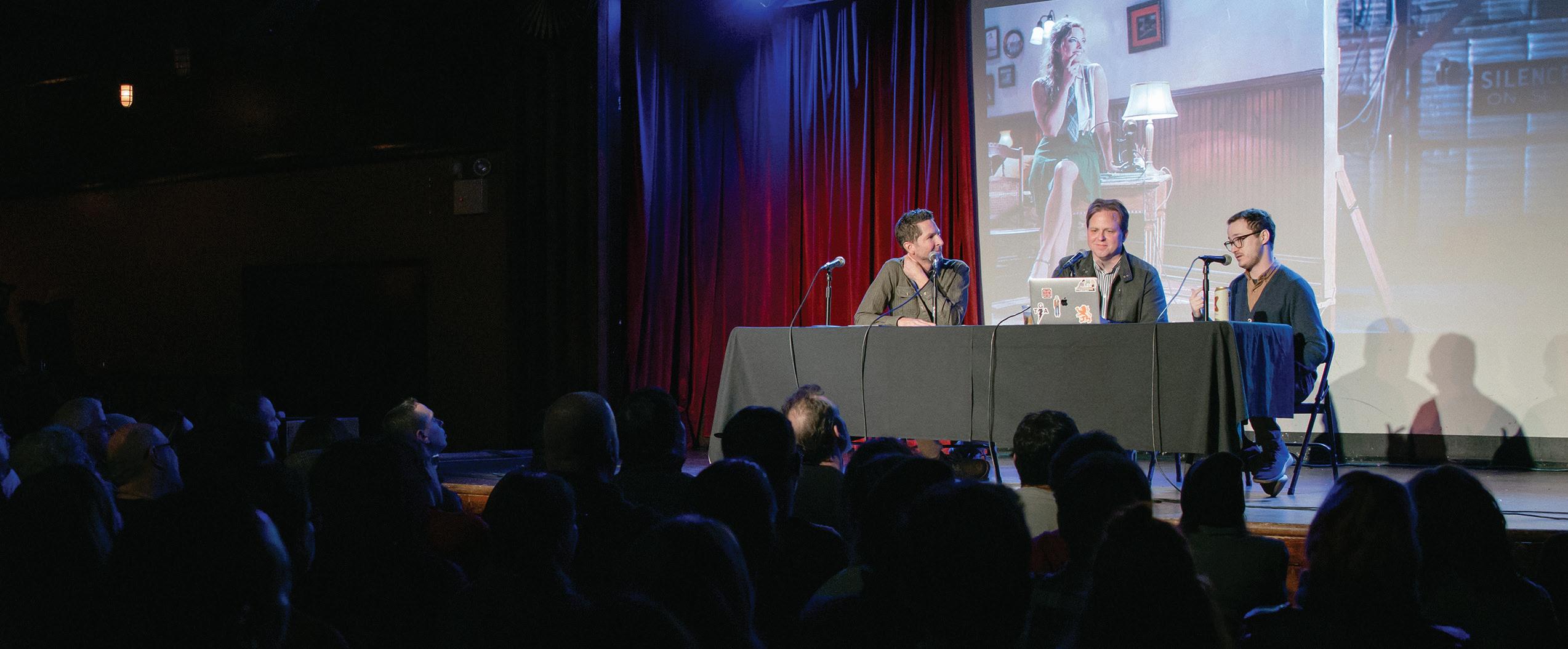
Local podcast and radio show Filmspotting will celebrate its 20th anniversary with an intimate festival full of special guests.
By KYLE LOGAN
The same goes for current Tribune film critic and frequent Filmspotting guest Michael Phillips, who jokes he’s “contractually obligated to mention Siskel and Ebert.” He sees the podcast as the continuation of a “long-running story [set in Chicago] of two people trying to figure out why they love or hate or like or eh-whatever a film . . . in a way other people enjoy.” Scott To-
“It can be hard to grasp where listeners are coming from, but these events are tangible evidence that Chicago is a base of support for the show, and the show has responded in kind.”
Theatre and the Gene Siskel Film Center. Kempenaar, who cofounded the Filmspotting podcast as Cinecast with now producer Sam Van Hallgren in 2005, says that he’s very careful to never make the comparison to Siskel and Ebert. But Larsen, who took over in 2012 as cohost from Matty Robinson (who had taken over from Van Hallgren), has no such qualms. When asked how he first discovered the show, Larsen says he heard it on WBEZ and “immediately appreciated it for having something of that conversational, Siskel-and-Ebert dynamic that I had grown up on.”

bias, a fellow Chicago critic and cohost of Filmspotting spin-o podcast The Next Picture Show, tells a slightly di erent story, one that uniquely places Filmspotting in the context of Chicago’s ever-changing critical lineage. Tobias says of his first Filmspotting appearance in 2007, “Adam opened the show by saying, ‘Scott, I know it’s not quite Ebert and Roeper, but I hope we’ll make it worth your while,’ and I said, ‘It’s even better than Ebert and Roeper for me,’ and I meant that sincerely.”
Tobias was one of the podcast’s first big
supporters after being “blown away by how good it was,” and in a 2006 piece at the A.V. Club, he said he was “in awe of Filmspotting.” He wasn’t the only early listener with words of extraordinary praise. The 2005 film Brick was so championed by Filmspotting in its first year that the hosts named their annual award for best breakthrough film “Golden Brick,” which

put them on the filmmaker’s radar. Writerdirector Rian Johnson—who since 2005 has directed a Star Wars movie and created a modern Hercule Poirot with Benoit Blanc in his Knives Out films—called the podcast “a force for good in the universe” on his first guest appearance on the show in 2006.
Over the years, Filmspotting “has changed its menu somewhat,” Phillips says, while maintaining several important “buts”: “loose enough to be unpredictable . . . but tight enough to be worth the minutes . . . casual but
incisive, and dripping with midwestern-ness, but wide open to the whole cinematic world.” The well-paced structure sees nearly every episode deftly move between discussions of upcoming and/or classic films, top fives on countless topics in film, and the fan-favorite “Massacre Theatre” segment, which sees the hosts perform hilariously over-the-top

renditions of famous scenes for listeners to write in and identify. The classic films often come as part of a “marathon” miniseries in which the hosts fill in blind spots from a movement, director, or genre and invite listeners to watch alongside them and join the conversation online.
That balance of humility, humor, and intellectual curiosity has gained the show a particularly loving audience that extends across oceans. Phillips says whenever he’s recognized in person by cinephiles, “It’s Filmspotting they
continued from p. 15
know best, and to which they feel a particular devotion.” He tells a story of participating on a jury at an international film festival where Slovenian critic and programmer Veronika Zakonjšek “couldn’t wait to talk to me about Filmspotting !” Kempenaar also recalls the 2013 Chicago International Film Festival where Kenyan filmmaker Ng’endo Mukii talked about “listening to Filmspotting as her connection to Chicago” during an acceptance speech. There’s a reason listeners from all over the world think about Chicago when they think about Filmspotting . There’s that aforementioned midwestern-ness and the occasional mention of local theaters, but it’s simpler than that: every episode begins with, “From Chicago.” Kempenaar says he never considered tying the show to Chicago’s illustrious film criticism history (along with Siskel and Ebert, he cites the Reader’s Jonathan Rosenbaum as “a staggering influence”). For him, opening the show with “From Chicago” was just a way to connect with the listeners. “At the time,” Kempenaar says, “you don’t really realize that, oh, that then becomes a signature thing.”
In the 20 years since he first called out the show’s hometown, a relationship has blossomed between the show and the city. Adam and Josh have built a film-loving and conversation-hungry community through an openness with listeners that includes regular in-person events and screenings. And while those shows have expanded to LA and New York in recent years, their home will always be Chicago, where their events are, as Tobias puts it, “always packed.” He notes that with such an internationally beloved show, “it can be hard to grasp where listeners are coming from, but these events are tangible evidence that Chicago is a base of support for the show, and the show has responded in kind.”
And with the upcoming Filmspotting Fest, the Filmspotting creators will treat Chicago cinephiles to their most ambitious event yet. The program consists of four Golden Brick winners, one classic from a marathon, and a film in the “ Filmspotting Pantheon” (a collection of films so adored by the hosts and listeners they cannot be mentioned in top-five segments).
Opening night at the Music Box will feature a 20th anniversary, 35 mm screening of Brick, with Rian Johnson joining the hosts for a postscreening discussion. Filmspotting’s relationship with Johnson is a key part of the podcast’s mythology, and there may be no greater celebration of both how far the show’s come
and how well it’s maintained its identity than this filmmaker-attended screening. Saturday will see four films play at the Film Center, and late Sunday morning will end the fest with a 30th anniversary, 35 mm screening of Richard Linklater’s Before Sunrise at the Music Box.
For fans new to the six programmed films, Larsen and Kempenaar agree that the one to see theatrically for the first time has to be Before Sunrise. “Imagine seeing Before Sunrise for the first time in a packed theater,” Larsen says, adding, “and then having the journey of the other two films yet ahead of you.” Kempenaar, who is also a professor at the University of Iowa, especially highlights the film’s appeal if “you’re in your early 20s and . . . you’re the same age as those characters.”
Their recommendations diverge on which films should be revisited, though. For longtime listeners who have seen all the films screening during the fest, Larsen suggests attending the screening of Satyajit’s Ray’s Pather Panchali (1955), while Kempenaar selects Kogonada’s Columbus (2017), both playing at the Film Center on March 1.
Pather Panchali , a major Indian film centered on the life of a poor boy and his family, became one of Larsen’s top ten films of all time after he saw it as part of a Filmspotting marathon of Ray’s films in 2015. He emphasizes the big screen opportunity to both “luxuriate under those black-and-white images” and wallow in “the sadness of the movie [which] is going to bring on a new power.”
Kempenaar similarly cites the big screen as a reason to come see Columbus, a movie with stunning cinematic compositions centering modernist architecture that follows the unlikely friendship between a young librarian and an older man in town. It also doesn’t hurt that filmmaker Kogonada will be in attendance.
Along with the two filmmakers, several longtime critic friends and regular guests on the show will join Kempenaar and Larsen for postmovie discussions. These conversations, with critics like Tobias and Slate’s Dana Stevens, will make the fest an outgrowth of the spirit that animates the show, one that’s just as invested in talking about cinema as in cinema itself.
As Larsen puts it, “You don’t need film critics to explain [what’s good about these movies] to you. But at the same time, if you get to partake in or listen to a good conversation about a movie afterwards, hopefully that’ll make the experience even better.” v m letters@chicagoreader.com
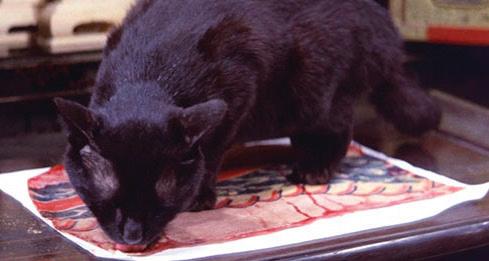




“ I s Flow (2024) a kids movie?” I typed into Google. Even after reading through several articles, I’m still not sure. Some say yes, others say no, largely citing the lack of dialogue and slow-moving plot. I wondered because, almost as a rule, I don’t really like content meant for kids. You won’t find me at Toy Story 4 or Inside Out 2, no matter how strong the pull of nostalgia is meant to be. (Not to be cliche, but I didn’t even really like them when I was a kid, as my parents let me watch pretty much whatever I wanted.) And sure, I prefer Bluey to the fascist state of Paw Patrol, but I don’t actually have any idea what those shows are. (I rely on memes and cool parent friends to fill me in on the political discourse of children’s programming.) I do like the Minions, yes, but I argue they emerge triumphant among the classic forms of ageless comedy, à la Chaplin or Keaton.
But if Flow does qualify as a kids’ movie, then maybe I’m getting soft. For I found the simplicity of its story, about a group of animals in the wake of a great flood (and with no humans around, eliciting a discomfiting, postapocalyptic vibe), to be profoundly moving. I’m also, of course, intrigued by the animals themselves, specifically a black cat and a capybara, two of my personal favorites, plus a labrador retriever, a secretary bird, and a lemur.
In interviews, its Latvian filmmaker Gints Zilbalodis has said that it’s about the animals overcoming their fears of the situation and one another, eventually becoming a community of sorts. In spite of its somewhat flat 3D animation style (made using open-source software, so at least impressive because of the ingenuity) and also because of its philosophical considerations of life and death, I took to Flow like the black cat to the water: apprehensive at first, but then fully immersed and aware of its potentialities.
I watched Flow at home, but in terms of actual moviegoing, another black cat piqued

my interest during the double feature of two pinky violence films at the Davis Theater: Yasuharu Hasebe’s Stray Cat Rock: Sex Hunter and Teruo Ishii’s Blind Woman’s Curse (both from 1970), presented by the Oscarbate Film Collective with writer and film historian Samm Deighan in person to provide illuminating introductions before each. The cat was in Blind Woman’s Curse ; it’s tied to the titular curse in portending the arrival of the blind woman warrior (Hoki Tokuda, the exwife of writer Henry Miller) to avenge herself against the woman (Meiko Kaji, also the star of Stray Cat Rock), the leader of a rival yakuza clan, who blinded her. One source defines pinky violence as “sexed up, bad girl action fi lm[s],” and that’s not wrong—they’re both all the better for it and still so much more, relics of the rigorous Japanese studio system and prime examples of the art to be found in exploitation cinema.
I’ve seen a handful of Atom Egoyan films over the years but not The Adjuster (1991), which I went down to Doc Films to see on Thursday. I was intrigued, if not completely sold; it’s very Lynchian, and so close to the filmmaker’s death, it felt like a pastiche. But I’m curious to watch more and fl esh out an opinion past this initial thought. My husband and I also went to the Gene Siskel Film Center’s Mystery Movie Monday, which ended up being F.W. Murnau’s Nosferatu: A Symphony of Horror (1922); I hadn’t seen it since our honeymoon in Portland, Oregon, 11 years ago, so it was nice to revisit, especially since I saw the recent remake. The original is better, but the new one does have more cats.
Until next time, moviegoers. —KAT SACHS v
The Moviegoer is the diary of a local film bu , collecting the best of what Chicago’s independent and underground film scene has to o er.
Get showtimes and see reviews of everything playing this week at chicagoreader.com/movies
What does it look like to be a single or widowed woman in your 50s? Lately, Hollywood seems obsessed with the idea. From Mr. Big’s untimely Peloton demise in And Just Like That . . . to the absent spouses of Anne Hathaway in The Idea of You (2024) and Nicole Kidman in A Family Affair (2024), the rom-com is grappling with age-gap relationships. Even our zany British heroine Bridget Jones, played by the beloved Renée Zellweger, isn’t spared.
In Bridget Jones: Mad About the Boy, Mark Darcy (Colin Firth) has died four years earlier on a humanitarian trip to Sudan, leaving Bridget, in her mid-50s, alone with the couple’s two raucous children. At a celebration of life, Bridget is (expectedly) unamused and frazzled by the evening of condolences. Her friends needle her to start dating again—and even Daniel Cleaver (Hugh Grant), the ghost of boyfriends past, gets in a friendly, somewhat horny hab about her being alone.

dren’s cinema that hasn’t quite been matched since; it’s anti-Brexit and anticarceral without ever losing the first film’s marmalade-sweet humor and warmth.
So she does . . . by downloading Tinder. Much like the protagonists in The Idea of You and A Family Affair, Bridget falls for a young Prince Charming-type. Hers is named Roxster, played by Leo Woodall. It’s a steamy romance, but it’s still just a flash in the pan. The romance stumbles along because the movie itself never appears to buy the age-gap relationship. Instead, Bridget’s most eligible bachelor is her son’s hard-ass science teacher, Mr. Wallaker, played by Chiwetel Ejiofor.
There’s not much to rave about in Mad About the Boy. It’s run-of-the-mill Bridget Jones, for the most part, yet the film deals some gut-wrenching blows that give this zany comedy a tender heart: Bridget and her children writing letters to Mr. Darcy on balloons, Bridget’s final conversation with her father (Jim Broadbent), and her son singing a tribute to his father at the school pageant, to name only a few.
What likely failed Mad About the Boy is its digital release. Despite all the repeated gags and such, it’s charming—and more emotionally vulnerable than many of its counterparts. A proper U.S. theatrical run might’ve made this a rom-com heater for Valentine’s Day. Instead, I fear this installment, perhaps the best of the three sequels, will be forgotten if it’s ever watched.
—MAXWELL RABB R, 124 min. Peacock
Abolitionist and feminist Angela Davis asked the public, “Are prisons obsolete?” and, in Paddington 2 (2017), a wrongly accused computer-generated bear bravely answered with a resounding yes. That movie set a precedent for joyful and politically conscious chil-
For one brief moment, Paddington 2 even usurped Citizen Kane (1941) as the best-reviewed film of all time on Rotten Tomatoes. It’s a pretty thankless task, then, to follow up one of the most universally beloved sequels in recent memory. Fortunately, Paddington in Peru isn’t interested in trying to one-up its predecessors. With usual director Paul King abdicating the throne to first-timer Dougal Wilson (King was busy directing 2023’s Paddington-adjacent Wonka), there’s a distinct slightness to this new Paddington adventure. It’s less a sequel than a spin-off, but that gives it more freedom to just be a silly good time.
Exonerated of all crimes a er the events of the last film, Paddington and his human family are now on a rescue mission to his home country of Peru to find his recently missing Aunt Lucy. Along the way to help/deter him (motivations get murky) are a suspicious singing nun (Olivia Colman) who runs the bear retirement home and an El Dorado–crazed Spaniard (Antonio Banderas) piloting a river boat down the Amazon.
Never in a million years would I have expected the third Paddington movie to channel Werner Herzog, but here we are: This is, no fooling, a loose remake of Herzog’s Aguirre, the Wrath of God (1972), with Banderas chewing up the scenery as five or six characters (most of whom are ghosts) and doing his best family-friendly Klaus Kinski impression. As in Wonka, Olivia Colman is still on history’s most whimsical post-Oscar victory lap, and just about every vaguely sinister line reading gets a laugh.
Is it possible to get more of these movies without having to wait another seven years? Could we send Paddington to a new exotic locale annually? When, for the love of god, will we get Paddington Vegas Vacation? —JOEY SHAPIRO PG, 106 min. Wide release in theaters v




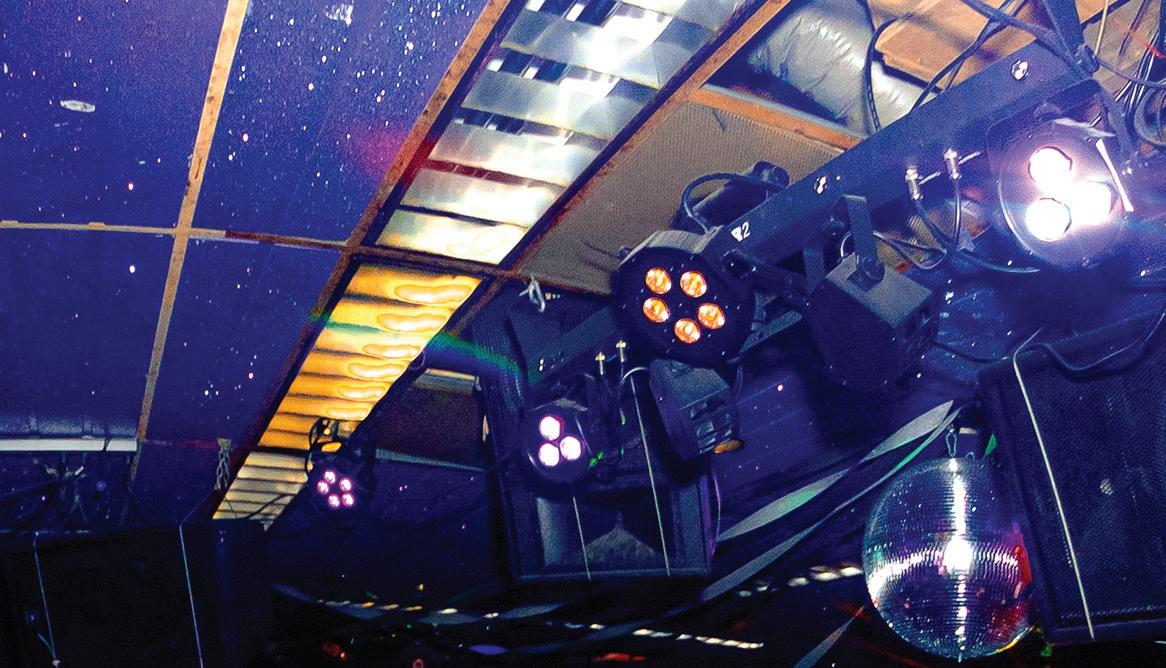
Screamo iconoclast Tyler Odom of Your Arms Are My Cocoon has already reinvented the genre once—and he’s just getting started.
By LEOR GALIL
Isaiah “Kit” Carson is one of the DIY musicians who helped make fifth-wave emo a subcultural phenomenon in the late 2010s. He’s the founding drummer in a mathy, whimsical Tennessee band called Guitar Fight From Fooly Cooly, which formed in 2018, and he’s made o stage contributions too. In early 2020, he launched the microlabel Sun Eater Records and recruited bands he knew to build its roster. Within months, he’d released cassettes by two of the scene’s biggest acts: Long Island’s Oolong and New Jersey’s Ogbert the Nerd. But the most significant release in Sun Eater’s first year was by Chicago-based multi-instrumentalist Tyler Odom. He makes inventive screamo under the name Your Arms Are My Cocoon, but Carson had never met him—and Odom had never performed YAAMC’s music outside his bedroom.
“That dude just came out of nowhere,” Carson says. “Just completely shocking.” He hadn’t even heard Your Arms Are My Cocoon until Odom sent him the project’s unreleased self-titled debut EP through the contact page on Sun Eater’s Limited Run site. Carson was bombarded with demos, and he says most of them came from teenagers just discovering music. “A lot of them play a G chord on an acoustic guitar and scream about crying or something,” he says. “Which is fine. I encourage it.” When he saw that YAAMC used the kind of silly, wordy song titles that had long been a cliche in emo (“Clifford the Big Red Stab Wound”), he expected more of the same.

When Carson clicked “play,” though, he heard something completely new to him.
Odom’s music fused the lo-fi comforts of bedroom pop with the spiky, unpredictable aggression of screamo—sighing accordion and wisps of xylophone jostled with knotty, rapid-fire guitar runs, clusters of electronic percussion, and hoarse screams. Carson remembers being won over by the looping curlicue guitar and four-on-the-floor bass drum of “Snowy!”
“I could tell,” Carson says, “whether or not everyone likes it, this is the type of music that only this person could make.”
On September 2, 2020, Sun Eater issued the Your Arms Are My Cocoon EP in an edition of 50 black-splattered pink cassettes. They sold
WEATHERDAY, YOUR ARMS ARE MY COCOON, SUMMER 2000, SWEET BIKE Sun 3/16, 6:30 PM, Subterranean, 2011 W. North, $22, $20 in advance, all ages
out within a day. “The first couple of months of the EP being out were really interesting,” Odom says. “For the first time in my life, people were paying attention to what I was making.”
Odom could never have predicted the impact his music would have. By combining bedroom pop with the rough-and-tumble version of screamo colloquially known as skramz, he helped birth a subculture within fifth-wave emo called “bedroom skramz.” That tag proliferated on Bandcamp—a hothouse for independent home-recorded music and marginal microgenres—and in February 2022, Bandcamp Daily published a report by Jude Noel on the emergence of a wider bedroom skramz phenomenon.
Since the initial explosion of bedroom skramz in late 2020, it’s evolved in several wildly different directions thanks to the likes of Texas-Oklahoma postrock four-piece Dead Butterflies, rootsy Nashville project So Long . . . Partner, and chiptune-tinged multinational ensemble Gingerbee. Odom’s innovation thrust Your Arms Are My Cocoon into the firmament of fifth-wave emo, itself a loose movement united by little but a drive to remake the genre. In July 2022, when the Ringer published “The Most Important Emo Song of Every Year,” it gave the YAAMC track “In October of 2019 I Called a Suicide Hotline for the First Time in My Life” the honor for 2020. In that piece, Arielle Gordon wrote, “Your Arms Are My Cocoon, the solo project of Tyler Odom, feels as close as anything to a definitive marker of the movement, a band to hold others up against to see if they fit the ethos of the Fifth Wave.”
Chicago multi-instrumentalist James McHenry, who makes discombobulating cybergrind as Blind Equation, was reminded of Indiana screamo band Merchant Ships when he first heard Your Arms Are My Cocoon. They’d existed for just a couple years in the late 2000s, but their volcanic outbursts made a big impression on him. “Your Arms Are My Cocoon’s EP was the closest that anything I’ve listened to had gotten to [Merchant Ships]—that display of raw emotion, and the production being so bare-bones,” McHenry says. “Another thing I really loved was all of the layers of instrumentation within the recordings—you hear all the bells and various different instruments. When I learned later on that it was all recorded on an iPhone, that fuckin’ blew my mind.”
Blind Equation and Your Arms Are My Cocoon both began as home-recording projects and evolved into live bands, and in spring 2024 they toured together for a month in southeast Asia, Australia, and New Zealand. Your Arms Are My Cocoon played as a four-piece, a configuration Odom had debuted roughly a year before. At the time of that tour, the only music YAAMC had put out since the 2020 EP had been an expanded reissue and contributions to two split releases. But Odom had already recorded a couple songs for the project’s fulllength debut, where he wanted to make a clean break from the EP. That album, released in August 2024 as Death of a Rabbit, would draw on his new full-band sound.
“I didn’t want to write more of what the EP was, because I had already done the EP,” Odom says. “I had already made the songs, and I had already fulfilled that vision. It didn’t make sense to me to do more of it. So I knew I wanted it to be bigger. I knew I wanted it to be grander in scope.”
Except for the drums, Odom played nearly everything himself on Death of a Rabbit, but its wide-screen sound feels like the output of a huge band. The album is a big shift, but a big shift was inevitable for a project Odom didn’t expect to have a second release.
“It was never the project’s intention to get to where it is now,” he says. “The project’s intention was to be released, and to be listened to by nobody, and then to be forgotten about.”
The idea for bedroom skramz took hold of Odom in 2018 and 2019. As a teenager living in the Houston suburb of Katy, Odom devoted most of his listening time to bedroom pop and screamo. As he fell asleep at night, his drifting mind would fuse them into a single sound.
None of his friends at the time shared his love of screamo. Odom himself hadn’t known what to make of it when he first encountered it in elementary school. He’d belatedly heard a 2006 Eyeball Records sampler that came packaged with copies of My Chemical Romance’s 2002 album, I Brought You My Bullets, You Brought Me Your Love. Screamo-adjacent New Jersey band the Number Twelve Looks Like You appeared on the comp.
“At first I fuckin’ hated it—I thought it was terrible,” Odom says. “I was like, ‘Why the fuck are they screaming in my ear? Jesus.’ But I kept coming back to it, and eventually I became obsessed with it.”
In middle school and high school, Odom focused most of his creativity on theater. But in 2016, still several years from graduation, he saw UK math-rock band TTNG play in Houston and bought their book of guitar tablature.
“I spent the entire summer doing nothing every single day except for learning their songs,” Odom says. He practiced for three to eight hours daily. “That was the first time I had picked up a guitar.”
Odom made mostly folk and bedroom pop in his first ventures into writing and recording music, inspired by hushed Philadelphia project Dandelion Hands and florid Los Angelesvia-Boston outfit Bedbug. “I loved how intimate and personal bedroom pop sounded,” Odom says. “It can feel so close, personally, but also nostalgic at the same time. It feels like music from a personal past, even if that’s not the kind of music that you listened to in your past.”

By that point, Odom also loved screamo, and he could hear bedroom pop’s expressions of vulnerability echoed in its much more confrontational songs. The idea to combine them felt so right that he couldn’t let it disappear into his dreams. He couldn’t find anyone nearby who wanted to play screamo, but bedroom pop had already shown him he could make music on his own—he just had to figure out how to fuse a quiet genre with a loud one.
The first bedroom skramz song Odom wrote was “Snowy!,” the last track on the 2020 EP. “I wrote it as a one-off,” he says. “I used everything I knew from practicing writing bedroom-pop songs, and I just put that into a song and screamed over it. I thought that was gonna be it. I left it to be its own thing for about a year, until I realized I wanted to make more things in that style.”
Odom began writing increasingly complex songs and adapted them for a variety of instruments. “A lot of the arrangements on the songs aren’t just guitar, bass, and programmed
drums,” he says. “It’s also accordion, violin, or xylophone. I felt like there was so much space that was left empty that needed to be filled.”
Except for some of the vocals, Odom recorded the EP in his literal bedroom. “I still lived with my parents, and I didn’t want them to hear me screaming,” he says. “So I would wait until they were out on a walk or something to record vocals. If I was really in a pinch—I really just wanted to get some stu down—I would go into my car in the parking lot of my high school, either right after school or in between classes, and record vocals there.”
Odom finished the EP in August 2020, the same month he moved from Katy to Chicago. He was drawn here by the improv comedy scene, and he enrolled at Columbia College. He still hasn’t tried his hand at improv here, and he quit Columbia after three months. “I wanted to stay in Chicago, even after I dropped out,” he says. “I knew that if music was what I wanted to do, then there was going to be a better scene in Chicago—and a better opportunity for me in Chicago to pursue that—than in small-town Texas.”
Your Arms Are My Cocoon steadily grew a cult fan base online, but Odom had trouble getting settled in Chicago. He ran out of cash shortly after dropping out of school, and he says he spent six months sleeping on a stranger’s couch with nowhere else to go. He finally began to feel settled in early 2022. “That’s when I started committing to the idea of Your Arms Are My Cocoon live shows,” Odom says.
Odom has never had a manager or publicist, so in summer 2020, as Sun Eater prepared to release the Your Arms Are My Cocoon EP, Carson gave him advice about using social media to get his music out to the world. After he began playing solo shows as Your Arms Are My Cocoon in early 2022, social media helped him put together a band.
“The first tour I did as a solo artist, playing with backing tracks and stuff, I knew that I wanted a full band,” Odom says. “I hated the way that the backing tracks sounded, and I hated the way the live sets as a whole sounded.” He recruited musicians through Twitter and Instagram, and they spent a few months rehearsing so they could play YAACM’s songs with no backing tracks at all. The full fourpiece band debuted at Bookclub’s defunct DIY space in April 2023. “Playing the music that I had written a couple years prior, with three other people helping fill out the sound—it felt so incredible,” Odom says. “It’s something that I will never, ever forget.”
Odom plays backed by bassist Dom Baylock, saxophonist Alyssa Mandel, and drummer Naser Mansour, all of whom he now counts among his best friends. Working with the band helped him beat the writer’s block that had plagued him since he dropped YAAMC. When Odom and his band arrived in Southeast Asia last spring, he’d written nearly half of Death of a Rabbit
Odom recorded the album’s vocals anywhere he could—a DIY recording studio, his Pilsen apartment, his car. “There were a couple of vocal takes that I even recorded when we were touring Asia—at the venue in Hong Kong,” he says. “But I scrapped [them] ’cause it sounded like shit in there.”
Death of a Rabbit is just as frenziedly eclectic as anything Odom has recorded, but the album has outgrown bedroom skramz. As radical as the genre was at its inception, it suffers from an excess of artists trying to recapture the feel of its foundational recordings—including the Your Arms Are My Cocoon EP. That’s something Odom expressly doesn’t want to do. “Runner Duck,” from the new album, runs more than ten minutes—more than half the length of the entire EP. Its grandiose changes befit a prog song, and the whole album has a vibrant richness that doesn’t sound like it could be contained by anybody’s childhood bedroom.
Odom is still blazing a trail, and he’s following it further and further away from where he started. “Your Arms Are My Cocoon is not a one-trick pony,” he says. “It’s going to continue to evolve and continue to sound di erent than anything else you’ve ever heard, because that’s what I want to do. I want to make music that I haven’t heard before.” v
m lgalil@chicagoreader.com
Even with Paul Anka in their corner, they never found a home for their first album—and that broke up the band.
By STEVE KRAKOW
Since 2005 Plastic Crimewave (aka Steve Krakow) has used the Secret History of Chicago Music to shine a light on worthy artists with Chicago ties who’ve been forgotten, underrated, or never noticed in the first place.
The Secret History of Chicago Music covers lots of bands who should’ve made it, but few failures are as ba ing as the story of Ruffian. The hardworking band seemed to have what it took: scorching hard-rock chops, a robust local following, and high-profile connections. In the early 80s, after toughing it out through years of musical evolution, Ruffian were playing exactly the kind of polished rock anthems that were burning up the radio. I asked founding keyboardist Nicholas Psyhogios about the band’s decadent highs and heartbreaking lows.
Psyhogios was born at Loretto Hospital in the Austin neighborhood on October 22, 1956. He grew up in suburban Norridge, where he picked up trumpet at age nine and played in concert and jazz bands all the way through college. To join his earliest garage bands, though, he learned another ax.
“I became interested in the bass guitar because of the Beatles and Paul McCartney, so that was my primary instrument in local bands,” Psyhogios says. “I also started noodling with the piano in my house and taught myself to play.” His tastes quickly evolved: “In my high school years, I was into progressive rock bands like Yes, Pink Floyd, and Emerson, Lake & Palmer—as well as heavier bands like Black Sabbath, Humble Pie, and Uriah Heep.”
Psyhogios attended Ridgewood High School, and his friend and classmate John Erst played bass in a band called Stagger. Erst convinced him to audition on keys in 1974, completing a five-piece lineup that also included three students from nearby Elmwood Park High: Frank Nadile (drums, vocals), Dan Giai-
mo (lead vocals), and Kevin Rathunde (guitar).
“When I joined Stagger, they were more into Earth, Wind & Fire and Chicago,” Psyhogios says. As different as their tastes were, they agreed on the importance of great vocals.
“We got a steady gig at Tenement Square, which was on Ontario and Fairbanks in the city. We used to have to go into the o ce on our breaks because we were all underage,” Psyhogios recalls. “After the summer of 1974, I left the group for a few months after John [Erst] left and was replaced by Jim Zito. I came back a few months later when I got a call from Frank [Nadile] pleading for me to return.”
Zito was also from Elmwood Park, and like Psyhogios he appreciated the heavier end of the radio-rock spectrum. “We adapted to the music Stagger was playing because it was steady money,” Psyhogios says. In early 1979, when the band spent three months gigging in Hawaii, they had the chance to tilt toward slightly harder sounds. “It was more of a rock crowd at the clubs we were playing. We found that bands like Toto, Kansas, Journey, and Boston were a great crossover of everyone’s taste in music.”
incident. To get to Hawaii, for instance, they bought a van to drive to California and catch their flight. The van didn’t cooperate.
“There was a lot of snow on the ground,” Psyhogios recalls. “Everything was loaded up, and the truck wouldn’t start. We called the dealership and were told they couldn’t get to it for days, so we went to the dealership at night and helped ourselves to one of the starters o one of their trucks in the lot. This put us way behind schedule, so we had to drive straight through to LA, taking turns sleeping.”
Stagger opened for acts as big and varied as Tower of Power and Dion. In 1981, they booked time at Gary Loizzo’s famed Pumpkin Studios in Oak Lawn to record some original songs. The resulting demo caught the ear of manager Joe Crispino, who’d recently worked with local hitmakers Tantrum. By this point, Stagger had
tom corner of the name. This was indicative of the ‘social athletic clubs’ in Chicago,” Psyhogios explains.
Crispino also got A&M Records interested in Ru an, and the label helped the band get bigger gigs supporting A&M artists. “We opened for the Ramones at the University of Chicago in May of 1983,” Psyhogios says. “I thought for sure we were going to bomb because we didn’t quite match their genre of music, but we received an incredible response.” They also did well supporting more mainstream acts. “Ruffian opened for Bryan Adams at Park West,” Psyhogios says. “It was near the beginning of his career and another A&M Records deal.”
Ruffian auditioned for Columbia Records (without success) at west-side restaurant Tuddi Toots. They also headlined shows at ChicagoFest, including one with O Broadway.

slimmed down to a four-piece—just Nadile, Psyhogios, Rathunde, and Zito—and Crispino suggested they change their name to Ru an.
Stagger gigged at colleges and clubs (including the Thirsty Whale and the Nickel Bag) and even toured a bit—though not without
“He wanted to make our identity more in tune with the streets of Chicago, so much so that our logo had a small SAC logo in the bot-
The next character to enter the Ruffian story, improbably enough, was famous Canadian singer-songwriter Paul Anka. He’d charted on the Billboard 100 for what would turn out to be the final time with his 1983 single “Hold Me ’Til the Mornin’ Comes.” Crispino
connected Anka with a demo Ru an had made at the Chicago Recording Company.
“Anka really liked our music, so he sent Mark Smith (later our producer) to Chicago to meet with us and see if we were the type of people he would want to associate with,” Psyhogios says. “Everywhere we went, people knew us either from the band or just as
ifornia. But you probably already know that record didn’t see the light of day—if it had, I wouldn’t be writing about Ru an fizzling out.
The best monument to Ruffian would be an album compiling their unreleased recordings, preferably on vinyl. Fellow radio-rock fans, let’s manifest this together.
friends. He noticed that we were well-known and a fun band to hang with, so he gave Anka the green light.”
In 1984, Ru an signed a deal with Paul Anka Productions, convinced their ship had come in. Anka produced an album for the band—in a TV spot aired that year on the short-lived show On Stage America , you can briefly see them working together in his home studio in Cal-
“For the rest of my life it will be a mystery to me as to why Anka never released our music,” says Psyhogios. “We kept reaching out to him for months, and he kept saying that he was shopping around for a distribution deal. We were all locked into contracts with Paulanne music publishing and recording artist contracts that completely inhibited what we could do as a band. These were contracts that we all signed happily, thinking this was going to be it.”
In those days, producers and labels could throw around a lot of money courting artists. It was easy for an up-and-coming band to get dazzled, and exclusive recording contracts were just as risky then as they are now.
“Anka would dangle the carrot by flying us around in his personal Learjet to go to Las Vegas and have his barber style our hair, and then fly back to LA for a photo shoot with none


Pop Bands from the '60s "Silhouettes" and "I'm into Something Good" Friday, February 28 7:30 PM STARRING AND






other than Norman See ,” Psyhogios recalls. “We were hanging out with Patrick Simmons from the Doobie Brothers, who loved our band and even played a solo on one of our songs. They were doing market research to see how di cult our band name would be for Japanese people to say, because the Japanese market was huge for American pop and rock bands. We never thought it would just dry up and end.”
Ru an had been together a decade, and they couldn’t hang on indefinitely in limbo. Psyhogios says they decided to call it a day in late 1984 or early ’85—he can’t remember for sure. “For all I know, I might still be under contract,” he says. “But I really don’t care anymore.”
Nadile, Rathunde, and Psyhogios soon reconnected with Erst to form a cover band, because some of them had gotten married or started families when they still thought Ru an had a windfall coming. When it failed to arrive, they needed to make some money quickly. Zito, Psyhogios, and Erst would reconvene in the late 80s as part of the Rascal Band. Music took a back seat for Psyhogios as he raised his kids, but as they got older, he returned to playing with Zito in Abdul’s Cactus
Remedy (formed in 2009) and with Erst in the Chicago Hitmen (formed in 2017). He still gigs locally as Chicago’s Own Piano Man, and Erst plays in his backing group as well as the current Hitmen lineup. In 2023, Psyhogios released an album of originals called It’s Never Too Soon to Start Over.
A Ru an reunion isn’t in the cards, sadly. Nadile and Zito have died, and Rathunde, now a professor at the University of Utah, no longer plays music publicly. Psyhogios hosts a Facebook page called Whatever Happened to Ru an? as a sort of memorial, and it’s full of photos, stories, and song links. At this point, I think the best monument to Ru an would be an album compiling their unreleased recordings, preferably on vinyl. Fellow radio-rock fans, let’s manifest this together—there’s no such thing as too many air-guitar songs. v
The radio version of the Secret History of Chicago Music airs on Outside the Loop on WGN Radio 720 AM, Saturdays at 5 AM with host Mike Stephen. Past shows are archived at outsidetheloopradio.com/tag/secrethistory-of-chicago-music.





of the Best Disco Bands of All Time
Down Tonight" and "That's the Way (I Like It)" Friday, March 7 8:00 PM Legendary Bass Player, Songwriter and Vocalist "Nights in White Satin" and "Ride My See-Saw" Saturday, March 1 7:00 PM Grammy® Award-Winning Folk-Bluegrass Group
Hypnotic Funk from Beyond the Grave
"Wagon Wheel" and "Paint This Town" Saturday, March 15 7:00 PM ELP Reunites Through Modern Technology "Lucky Man" and "Fanfare for the Common Man" Saturday, March 22 7:00 PM
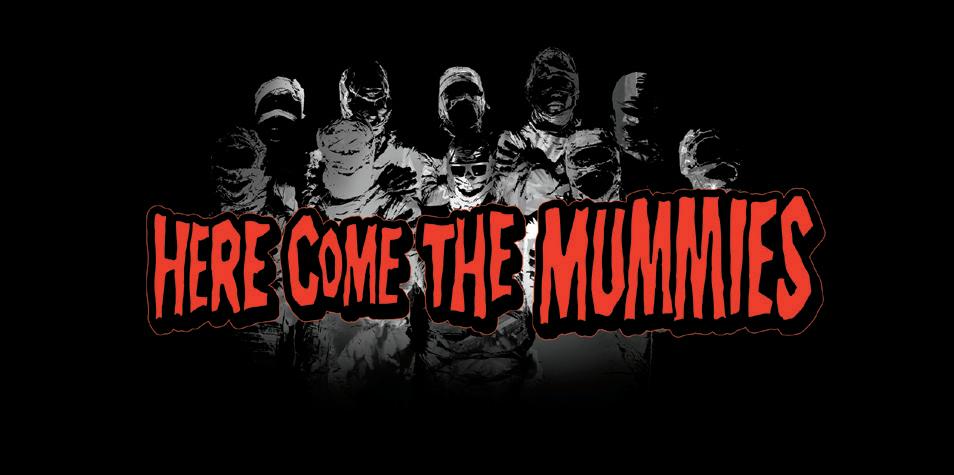
"Freak Flag" and "My Party" Thursday, March 20 7:30 PM

Recommended and notable shows with critics’ insights for the week of February 20
PICK OF THE WEEK
Horsegirl share Chicago’s youth indie scene with the world on their new second album

HORSEGIRL, LIFEGUARD, ANSWERING MACHINES
Sat 2/22, 7 PM, Metro, 3730 N. Clark, $30, $25 in advance. b
THE THREE MEMBERS OF HORSEGIRL made their new second album, Phonetics On and On, while wearing multiple sweaters apiece to fight the January cold in the studio—and they couldn’t have evoked the romance of indie rock’s make-do early days any better if they’d tried. Horsegirl broke out of Chicago’s youth-centric Hallogallo scene in 2021 by signing to Matador, a fitting home for a band whose shaggy sound is steeped in the indie rock of yore. Horsegirl’s anything-goes, anyonecan-do-it outlook, which embraces punk as a spirit rather than as a concrete genre, echoes the idiosyncratic boldness of feminist postpunk ensemble the Raincoats—right down to their scrappy beginnings. But Phonetics On and On is a polished a air that pulls away from Horsegirl’s noisy, tangled early sound to try something sparse but fresh. The band recorded it with musician and producer Cate Le Bon at Wilco’s studio,
the Loft, and they knew they wanted the sessions to be pristine—they turned the heat o so the noise from the system wouldn’t interfere with the room tone. The minimalist vibe of Phonetics On and On recalls rock greats who balanced pop simplicity with the avant-garde—the sawing strings on the glum “In Twos,” for instance, remind me of John Cale. But the band always keep their feet in the present, and in light of pop’s endless thirst for reinvention, their choice to evolve within a decadesold aesthetic makes their music feel radical. Early single “Julie” rides a slow, steady, bell-like guitar pattern that’s almost aggressively monotonous, matching the restrained a ect of guitarist-vocalist Penelope Lowenstein as she dryly sings about an indecisive young woman contemplating her cloudy future. It’s sweet, a little strange, and unlike much else I’ve heard the past year. —LEOR GALIL
Semler Isabell Pless opens. 9 PM, Sleeping Village, 3734 W. Belmont, $21.63. 21+
My best friend Abbey is a queer Christian, and I’m a kind of Satanist (though for complicated reasons I’m not associated with the Satanic Temple). Despite our vastly different faiths, we agree on most things, including our love of queer alt-Christian singersongwriter Grace Semler Baldridge, who makes music as Semler. Though I wasn’t raised in the church, I did attend Catholic school for two years (for some reason), and as a queer person I experienced some of the same marginalization Semler sings about. I remember the boys who would laugh about “sending all the gays to Texas and blowing it up.” So when I first heard “Jesus From Texas,” which explores the challenges Semler faced growing up Christian and queer, I cried.
Semler first came into the spotlight as a regular guest host of The Young Turks and cohost of the TYT infotainment show Pop Trigger . They began releasing music in 2017 and burst onto the music scene on the back of their 2018 full-length debut, Six Feet Under All the Same . Since then, they’ve released four EPs, including 2021’s Preacher’s Kid , which took the Internet by storm. Earlier this year they released the single “Amen,” which opens with a quote from Jacqui Lewis, a progressive minister at Middle Collegiate Church. “We only know God because we know each other,” Lewis says, speaking to the affirming communities both Semler and Lewis hope to foster. Considering the word “amen” is derived from the Hebrew “āmēn,” which means “certainly” or “so be it,” the song seems to say that instead of proclaiming “Love is love” we should instead be saying “Love is truth.”
Semler’s music stands at the crossroads of two cultures that have long been at odds: the LGBTQ+ community and conservative Christians. But while these two groups might have seemed distinctly separate in the past, they are increasingly finding new ways to coexist. The embrace of Semler among fans of Christian music feels like a testament to that progress. Semler croons about religious trauma in sincere and calming tones. “My best friend found God, so we lost touch,” they sing on “Jesus From Texas.” “I hope she finds love and peace / And if her kid comes out, I hope that she calls me.” In just three lines, they speak to the crushing loneliness of being queer in a conservative community and of losing people to bigotry but still craving the love of those you once called family. If you also relate to that sense of loss, you can join Abbey and me at Sleeping Village (I’ve been told we give good hugs). Look for the angel halo next to the devil horns. —CHARLI RENKEN
FRIDAY21
Egyptian Lover See also Music Frozen Dancing on Sat 2/22. 10 PM, Empty Bottle, 1035 N. Western, $20. 21+
Music Frozen Dancing is back, and thanks to its headliner, west-coast hip-hop pioneer the Egyptian Lover, this year’s edition of Ukrainian Village’s
best midwinter outdoor music festival could be its freakiest yet. Los Angeles–born musician and producer Gregory James Broussard adopted his stage name even before he began experimenting with mixtapes and rapping as a teen in the 70s. “Growing up in the hood, the first thing you want to do is get out the hood,” he said during a 2013 Red Bull Music Academy lecture. “So in my mind I took myself out the hood and I just took myself to any place I could find, which was probably just Egypt at the time.” As a bonus, he noted, women liked his nickname better than the ones that some of his running buddies chose, like “Mr. Guns” or “Knock You Out.”
Broussard emerged on the party scene in the early 1980s as a DJ for legendary LA hip-hop and funk collective Uncle Jamm’s Army, whose roster also included future westcoast hip-hop greats Ice-T, DJ Pooh, and DJ Bobcat. He became one of its most popular members on the strength of tracks such as 1983’s “Dial-a-Freak” and soon established a solo career, cra ing serious jams that never took themselves too seriously. The Egyptian Lover shaped his futuristic, experimental sound with his love of Krautrock, Prince, funk, and several burgeoning electronic genres, incorporating 808 beats, minimal rapping, and copious orgiastic breathing from a seemingly endless roster of proud freaks. In 1984, he scored a hit with “Egypt, Egypt,” and it quickly became a staple of the breakdancing scene. Later that year, Broussard cracked the Billboard 200 with his debut full-length, On the Nile , and his 1986 album, One Track Mind , produced the charting singles “The Lover” and “Freak-a-Holic.” He’d release several more albums over the next two decades, remaining steadfast in his approach despite changing trends and industry pressures. Today he’s revered as an artist’s artist

by several subsequent generations of hip-hop and dance musicians. The Egyptian Lover’s two back-toback Chicago appearances are great opportunities to embrace your inner freak and dance like the 80s never ended. —JAMIE LUDWIG
Molchat Doma Sextile open. 7:30 PM, Salt Shed, 1357 N. Elston, $42.50-$90. 17+
Molchat Doma are truly Internet-era postpunks. In April 2020, the Belarusian band went viral on TikTok when a Russian expat named Leon Verdinsky


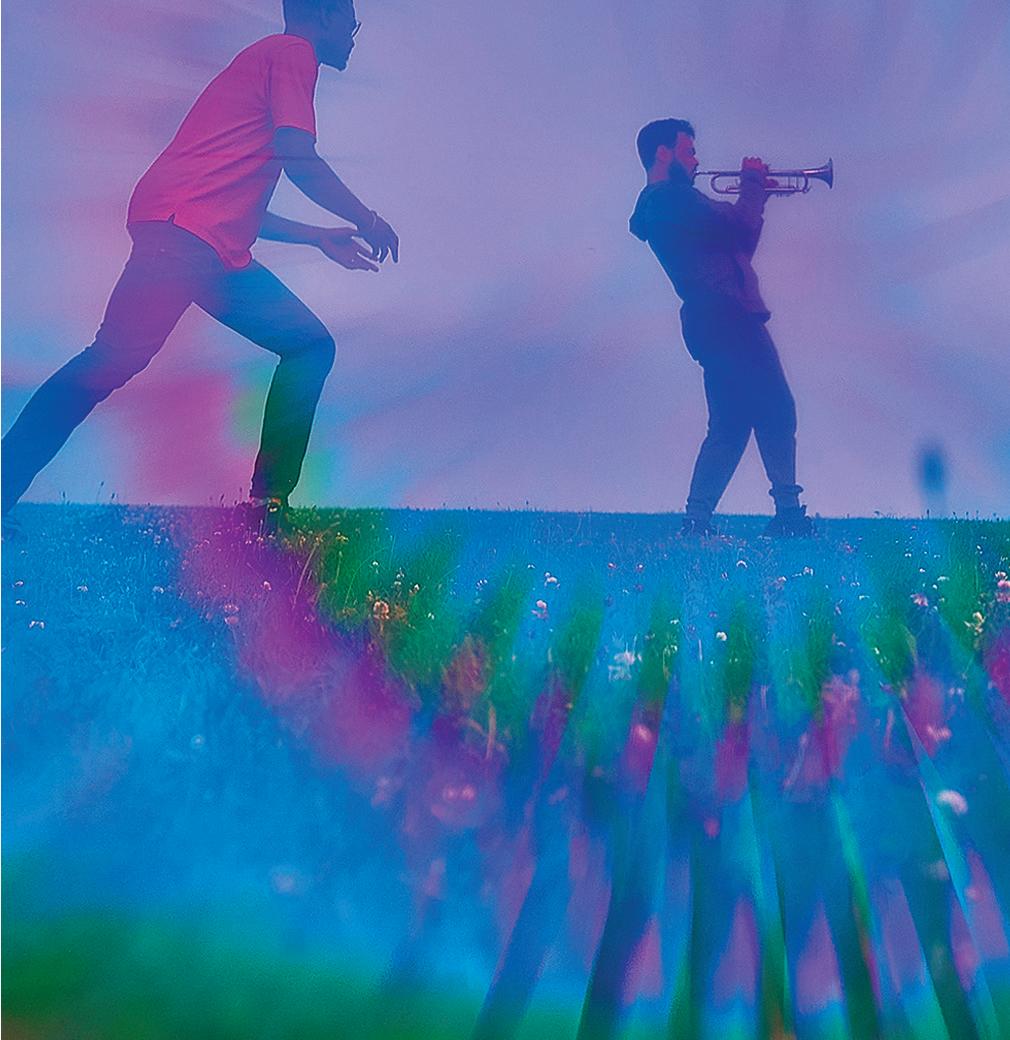



continued from p. 23
used their song “Sudno” in a montage designed to capture the feeling of his adolescence in Saint Petersburg. The track’s sparse production, low and ominously muffled vocals, and wandering guitar line feel like stumbling through industrial spaces, as though you’re stuck in the game Doom without a gun; it pairs perfectly with Verdinsky’s footage of teens writhing in graffiti-covered spaces like subway stations and warehouses and toasting with bottles of beer on the beach. By June, the TikTok story had racked up close to six million views, and Molchat Doma grew from a niche band within synthwave communities to one of the most streamed artists of the genre.
But Molchat Doma’s ascent didn’t start with TikTok. It really began with YouTube, thanks to an Australian who runs a very popular account as Harakiri Diat. Like many tastemaking subcultural aggregators, Harakiri Diat shares music and videos by underground, emerging, and archival artists—in this case, specifically in the punk and coldwave spaces—and in 2019, he uploaded Molchat Doma’s 2018 debut full-length, Etazhi. At the time, Molchat Doma were signed to a microlabel in Germany called Detriti, but the record racked up so many plays— more than two million by the end of that year—that the band caught the attention of Sacred Bones. The Brooklyn-based esoteric boutique label signed the group and set out to reissue Etazhi , triggering a heated— heated —rights spat with Detriti that’s still generating Reddit gossip. The controversy never hindered the band’s success. As they’ve grown their fan base with 2020’s Monument and last year’s Belaya Polosa, that early hiccup has only added to their mythology. Molchat Doma are now based in Los Angeles, and every time they announce another Chicago concert, it’s at a bigger venue. Has their live show kept pace with their popularity? There’s only one way to find out. —MICCO CAPORALE
Egyptian Lover See Fri 2/21. Egyptian Lover headlines Music Frozen Dancing. Bib, Landowner, Double Over, Clickbait, Rent Control (DJ set), and Signal Records (DJ set) open. 1 PM–dark, outside the Empty Bottle, Cortez and Western. F b
Horsegirl See Pick of the Week on page 22. Lifeguard and Answering Machines open. 7 PM, Metro, 3730 N. Clark, $30, $25 in advance. b
Hour Macie Stewart & Zander Raymond and Jason Calhoun open. 8 PM, Judson & Moore, 3057 N. Rockwell, $17.01, $15 in advance. 21+
Instrumental ambient ensemble Hour draw their power from several east-coast music communities along the stretch between Maine and the group’s spiritual home in Philadelphia. Bandleader and multi-instrumentalist Michael Cormier- O’Leary operates within several scenes himself. He plays percussion, guitar, and keys in soft- footed Philly alt-country group Friendship, alongside Peter Gill, who fronts gritty power-pop group 2nd Grade.



That’s him shaking a tambourine behind Gill on “Ice Cream Social Acid Test,” one of the best songs from 2nd Grade’s latest album, the 2024 bop parade Scheduled Explosions. Gill is also one of 11 musicians
gathered by Cormier-O’Leary to record Hour’s album Ease the Work (released in April via CormierO’Leary’s label, Dear Life). Hour sounds like a project pulled between sym-
Find more music listings at chicagoreader.com/musicreviews
phonic ambitions and the urge to rock, and the space between those two poles nourishes Ease the Work . The group’s DIY punk contingent foregrounds a restrained alt-country swagger, while the four-piece string section and the resonant clarinet of Keith J. Nelson (a frequent collaborator of New York City–based Orindal artist Matt Bachmann) provide a gussied-up refinement that makes these lush, serene miniatures sound like they’re floating in the air. Tonight’s performance follows the February 14 release of Subminiature, a live album that consists largely of soundboard recordings by Hour pianist and Philadelphia audio engineer Lucas Knapp. One highlight is a cover of Patsy Cline’s “I Fall to Pieces” sung with old-timey panache by Philly folkie Jacob Augustine—slightly out of character for a project that otherwise doesn’t use vocals—and the whole record documents how good this material sounds in concert.
—LEOR
GALIL
Trupa Trupa Model Living and Plum open. 9 PM, Empty Bottle, 1035 N. Western, $16. 21+
Trupa Trupa make rickety, bleak music for surviving authoritarianism. Since self-releasing their fulllength debut, 2011’s LP , the trio from the coast of northern Poland have wandered through the foggiest and most aching parts of psych and garage rock, postpunk, and posthardcore to create a sound whose greatest consistency is its ability to express the darkest aspects of the human experience—and the beauty we must nurture despite it all. Singer and guitarist Grzegorz Kwiatkowski knows something about facing horrors with clarity. His wife’s family are descendants of Holocaust survivors, and his grandfather was a prisoner at the Stutthof concentration camp. Kwiatkowski is an outspoken antifascist, and he’s devoted his life to creating music, writing poetry, and expanding scholarship that addresses Poland’s authoritarian past and present. In 2019, he made headlines because, in 2015, while walking in a forest outside Gdańsk, he and a friend had discovered a graveyard of thousands of shoes taken from some of the 110,000 people who passed through the Stutthof camp, of whom 65,000 were murdered. But in 2018, Poland passed a law making it more or less illegal to suggest that the Polish government or its citizens had been complicit in the Holocaust. When Kwiatkowski spoke out about the shoes that remained in the woods, he suggested that they were being le to disintegrate along with the truth of Poland’s role in Nazism. Trupa Trupa’s music has varied over time. Over six records and a smattering of singles and EPs, they’ve drawn influence from everything from the warm psychedelic pop of the Beatles to the icy atmospheric postpunk of Killing Joke. All the while, they’ve been unafraid to confront issues as grave as genocide head-on: “We don’t exist at all / We won’t exist no more,” they sing in the refrain of 2013’s “Exist.” Though the song begins in a languid, melancholy, and matter-of-fact tone, it ends with whimsical humming, breezy guitars, and hip-swinging rhythms that capture a sense of running full force toward a future worth fighting for. If the news has you feeling fragile and despondent, Trupa Trupa understand. This is a show for comrades. —MICCO CAPORALE v




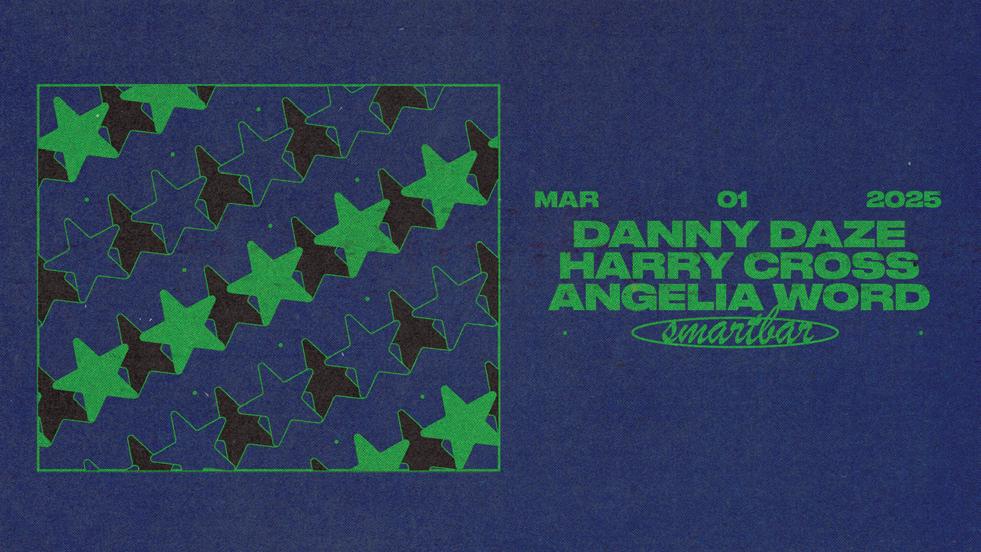

5/20 Stephen Malkmus
5/25 Florist
WEDNESDAY, FEBRUARY 26 7:30PM
CHICAGO LABEL International Anthem turned ten in December, but it’s instead decided to celebrate its coming 11th anniversary throughout 2025. “We liked the number 11 more than the number ten,” says Scott McNiece , who cofounded the label with David Allen in 2014. McNiece says the two of them started brainstorming with marketing and events head Alejandro Ayala (aka King Hippo ) a couple years ago, looking at ideas for how to mark the occasion. The campaign they’ve christened “IA11” includes re issues and big European concerts, and last week the label announced special programming for locals: a Hungry Brain residency called “11 of 11,” where musicians respond to and reinterpret crucial International Anthem albums. It runs throughout 2025 on the last Monday of every month, beginning Monday, February 24, with a night dedicated to Ben LaMar Gay ’s 2018 debut, Downtown Castles Can Never Block the Sun
A furry ear to the ground of the local music scene
tional essays and reflections around those albums. “This event series will be another way of celebrating those records and bringing people together around them, while also doing something kind of new—bringing in different musicians to play that music,” he says.
The first three IA11 Editions will correspond to the first three 11 of 11 concerts. Downtown Castles is happening first in order to line up with Gay’s schedule. “Ben told me he wanted

seven, eight years ago,” McNiece says. “Ten years ago, in the case of Rob’s. But then also for the musicians who are playing it, for them to bring friends out who maybe haven’t heard the record before and don’t know anything about it. I hope it can be a nice chance to get back in touch with roots while actually growing community in different directions.” Tickets to 11 of 11 cost $15, and the music starts at 8:30 PM.
TUESDAY, MARCH 4 8PM Masters of Hawaiian Music George Kahumoku Jr., Herb Ohta Jr. & Sonny Lim In Maurer Hall
SATURDAY, MARCH 7 8PM Eilen Jewell with special guest Nikki O'Neill In Maurer Hall
SUNDAY, MARCH 8 10:30AM Justin Roberts & the Not Ready for Naptime Players In
FRIDAY, MARCH 9 7PM Sam Bush In Maurer Hall
The residency recalls the way McNiece first got involved in the local jazz scene. In 2011, he launched a Monday series called Trio in Curio in the basement lounge beneath Gilt Bar, near Merchandise Mart. “I loved the idea of getting back to those roots as part of our anniversary,” McNiece says. “Not just going bigger with these really big, ridiculous European festival shows, but also going smaller and getting back to the basic unit of what it was that we did.”


At the same time as Trio in Curio, the Hungry Brain hosted Umbrella Music’s Transmission series—which makes it especially significant to McNiece that the same venue will host 11 of 11. “The Brain was where I fell in love with Chicago jazz and improvised music,” he says. “I came from a punk-rock-drummer background. As my horizons were expanding in my early 20s, I just happened to cross a Sunday-night jazz Transmission at the Brain, and it blew my ears open.”
Each album spotlighted in an 11 of 11 performance is also part of the IA11 reissue series. International Anthem announced the first batch of IA11 Editions last month: Downtown Castles Can Never Block the Sun , of course; Makaya McCraven’s In the Moment, his 2015 debut for International Anthem; and the label’s first album release, Rob Mazurek’s 2014 trio record Alternate Moon Cycles. The reissues will include new booklets and liner notes, and McNiece says IA plans to publish addi-
to be at his,” McNiece says. Gay also helped put together the trio that will reinterpret his work: He asked drummer Frank Morrison to lead the band, and Morrison recruited pianist Elio Wijaya and bassist Micah Collier . Next month, trombonist Emma Blau will reimagine Mazurek’s album; in April, saxophonist Anisha Rush, who apprenticed with McCraven as part of a New Music USA program, will tackle In the Moment. The performances will be preceded by listening sessions with the original recordings.
“My hope is for people who were around for the making of those records to come out, hang, and want to listen to the album and share stories about how fun it was making it
Lee Collins has an almost mythical status in that community, but if you don’t already know his reputation, it can be hard for you to figure out why—especially if you limit yourself to physical recordings. Discogs lists just a couple CD-Rs to his name, released by Soul in the Hole , a label and production company cofounded by Chicago DJ and producer Sadar Bahar in 1989. But despite Collins’s thin catalog, he’s been DJing for more than 40 years, and he played a key role in the evolution of disco into house music. In 1983, he launched a dance show on WHPK called Disco Madness , and within a few years he was spinning at Robert Williams’s subterranean nightclub, the Muzic Box Collins’s skills on the turntables have earned him respect among longtime house heads and crucial figures shaping the genre’s future. Detroit house standard-bearer Theo Parrish , in a sprawling interview with Mike Rubin for the 2023 publication Blank Forms 09: Sound Signatures , calls Collins his number one favorite DJ. “He’s one of the few dudes out of Chicago that will bridge modern stuff with older material seamlessly and make it work,” Parrish explains. “Lee, he was one of the first ones doing that.”
Collins has remained active, and he’s performed a couple times at Podlasie within the past 14 months. But he’s also been struggling with his health. Last month, Bahar launched a GoFundMe to help Collins cover his bills for cancer treatment. “This is our chance to give this incredible man his flowers while he can still smell them,” the GoFundMe says, “to remind him of how much he means to all of us.”
—LEOR
GALIL
Got a tip? Tweet @Gossip_Wolf or email gossipwolf@chicagoreader.com.


Waiting List Open for 1 Bedroom Subsidized Apartments - Seniors and Disabled
Moogoong Terrace 4848 N. Kedzie Avenue Chicago, IL 60625
Application Period from February 10March 31, 2025
Interested persons should contact the Management Office for an application by calling (773) 478-0085 or picking up during office hours Monday through Friday 9:00 a.m. - 5:00 p.m.
Income Restricted (773) 478-0085

Associate Consultant, Field Engineer - (Chicago, IL), WSP USA Inc.: Mnge cst & schdule of Clnt cnstrctn prjcts. Salary $118,581.00/yr. Stnrd Bnfts. Reqs: Master’s (or frgn equiv) in Cvl or Strctrl Engnrng, or rltd & 2 yrs exp as a Site Engr, Strctrl Dsgn Engr, Cvl Engnr, or rltd. Intrnshp, Grad Assistntshp, or smilar exp acptd. Will acpt Bach + 5 yrs of exp. Apply to jobs@wsp.com, Ref: 5024
Associate Director - Turner & Townsend (Chicago, IL)
Salary Range: $150,000.00 to $185,000.00/year. Must have proof of legal authorization to work in U.S. Apply online at https://www. turnerandtownsend.com/ (under Posting Number REF240630). To view full information about the job opportunities including the full job description, related occupation, education and experience requirements please refer to the internet posting at https://www. turnerandtownsend. com/ under Posting Number above.
Bodorlaser Inc. seeks the following: Sales Engineer (Schaumburg, IL). Bachelor’s or higher in EE, Electrical/ Electronics Engrg Tech or reltd field. Proficiency in AutoCAD sw. Proficiency in MS Excel & PowerPoint. X’lnt comm & analytics skills w/ strong problem-solving mindset. $74,880/yr. Service Engineer (Wayne, Michigan). Master’s in ME, ME & Applied Mech, or a reltd field. 6 mos work exp in the field of ME. Proficiency in mech design w/CAD sw. X’lnt analytical skills w/ strong problem-solving mindset. $87,589/yr. Remote position in Wayne, Michigan. Apply to 1230 Remington Rd, Schaumburg, IL 60173, or email to grace. jin@bodorlaser.com
Medline Industries, LP in Northfield, IL has multi open’gs:
A) Sr. IS Business Systems Analyst (Zendesk) to collaborate with bus partners & application dvlpmnt teams to deliver & maintain req technology sol’ns. No trvl req. WFH benefit avail; must be avail to come into the Northfield office for bi-weekly mtgs. Salary: $126,755/ yr. Apply At: https:// tinyurl.com/2edwmd7s
B) Sr. Demand Planner to be responsible for the collaborative dvlpmnt, monitoring, & communication of the demand forecast for assigned bus units. No trvl req. WFH benefit avail. Salary: $85,675/yr. Apply At: https:// tinyurl.com/ye26han6
Senior Customer Insights Program Manager (Softchoice Corporation, Chicago, IL): Adim corporate voice of custmr prgrm; Validate data to ensure accrcy of systm & mdls; Prvd mgmt w/ anlys & rslts to assist in dcsn makg & slv custmr prblms; Generate custmr insght rprts for mgmnt utlzg statstcl tests, & offr sltns based on rslts; Collab w/ depts to implmnt imprvmnts; Mng info in Qualtrics. May telecommute. Reqd Exp: Bachelor’s degree in any fld & 2 yrs exp in job offrd or rltd cstmr exp occ. Exp: 1 yr exp using Qualtrics or Medallia s/w platforms. Must have basic certfctn in Qualtrics or Medallia, & elgble to sit for CCXP exam. Email C.V. to USrecruitment@ softchoice.com. Ref ID: SC2024MO.
Sr. IT Analyst, Logistics & Warehouse Operations. Ulta, Inc. Bolingbrook, IL. Can work remotely/ telecommute up to 100%.
Functional responsibility for integration into SAP host systems. BS: CS, Engg, or rel. 5 yrs exp supporting warehouse
mgmt sys. 10% domestic trav reqd. Other exp req. Pay $148,949 - $149,949/yr. Job ID 339026. Apply: https:// careers.ulta.com/careers/
Chinatown Museum Foundation seeks a Curator of Collections in Chicago, IL resp. for overseeing the op. w/in the Collections Dept. Req. MS 6 mos. exp. as an Intern &/or Researcher at an Art Museum. Must be able to read & write Chinese language, & speak Mandarin Chinese. Prior exp. must incl. exp. accessioning & cataloging new objs. using PastPerfect Museum s/w.; perf. research on donated objs.; digitizing (scanning) 2-D photos., docs., slides, & archival recs.; photographing 3-D objects. To apply: submit resume via email to careers@camochicago. org Must ref. Job Title. careers@camochicago.org

ORGANIZING AND CLEANING SERVICES: especially for people who need an organizing service because of depression, elderly, physical or mental challenges or other causes for your home’s clutter, disorganization, dysfunction, etc. We can organize for the downsizing of your current possessions to more easily move into a smaller home. With your help, we can help to organize your move. We can organize and clean for the deceased in lieu of having the bereaved needing to do the preparation to sell or rent the deceased’s home. We are absolutely not judgmental; we’ve seen and done “worse” than your job assignment. With your help, can we please help you? Chestnut Cleaning Service: 312-332-5575. www.ChestnutCleaning. com www. ChestnutCleaning.com

Charles MJM 5’11 175 Looking For Mature Jewish Female Weekend Playmate Wine Hot Oil Oral Massages Spanking Antiques Thrift Shops Hot Sex Bondage Can host discreet call Charles-224-292-9899
By DAN SAVAGE
Dear readers: I haven’t felt so good since visiting a rustic pluck-your-ownchicken place for dinner last week, and (doctor’s orders) I’m not allowed to operate my advice column until I’m feeling better. Please enjoy this column from February 17, 2017. —Dan
Q : I am a straight married man. My wife and I have a four-year-old and a threemonth-old. We’ve just started having intercourse again. For Valentine’s Day, we spent the night in a B&B while grandma watched the kids. We had edibles, drank sparkling wine, and then fucked. It was amazing. A er we came and while we were still stoned and drunk, my wife mentioned she was open to inviting others into our sex life. I asked about getting a professional sex worker. She said no. But maybe if we were in a bar (we’re never in bars) and met someone (a unicorn), she might be into it. Anal came up. She’s always said she’s up for trying anything once. I have a desire to experiment with anal. (Not just me entering her, but her pegging me as well.) I asked if she would use the vibrator we brought on me, just to experiment. She said she was too high to do anything. I felt let down. I feel she unknowingly teased me with fantasies I have, not knowing I actually have them. We have a good sex life, and I’m willing to write off the fantasies we discussed while high and drunk. It’s the teasing that drove me crazy. —HAVING AND REALIZING DESIRES
P.S. I’m in no hurry. We just had a baby, and I don’t want to pressure my wife right now. My fear is that she may only like the idea of exploring our sexuality together and not the reality of it.
a : Some people think about, talk about, and masturbate about certain fantasies without ever wanting to realize them. Let’s call them Team Fantasize. Some people think and talk about certain fantasies and would very much like to realize them. Let’s call them Team Realize. There’s nothing wrong with either team. But when someone on Team Fantasize is married to someone on Team Realize, well, that can be a problem. Knowing your spouse is turned on by fantasies you share but rules out realizing them—or sets impossible conditions for realizing them—can be extremely frustrating. And sometimes a frustrated Team Realize spouse will say something like this to their Team Fantasize mate: “Talking about these fantasies together—this kind of dirty talk—it gets my hopes up about actually doing it. If it’s never going to happen, we have to stop talking about it, because it’s frustrating.”
The problem with that approach? Swingers clubs, BDSM parties, and the strapon dildo sections of your finer sex-positive sex-toy stores everywhere are filled with couples who used to be on opposite teams—one from Team Fantasize, the other from Team Realize—but they’re both on Team Realize now. And what got them
on the same team? Continuing to discuss and share fantasies, even at the risk of frustrating the Team Realize spouse.
So if you ever want to have that threesome or experiment with anal, HARD, you need to keep talking with your wife about these fantasies—and you need to tell her your fantasies too! Tell her you’re not pressuring her, of course, but let her know these are things you would actually like to do, and the more you talk about them, the more you want to do them. If she keeps talking with you about them, that’s a sign. Not a sign that she’s a cruel tease, HARD, but a sign that she’s inching closer toward pulling on a Team Realize jersey.
P.S. If your wife doesn’t know you have these fantasies—and is consequently teasing you “unknowingly,” that’s your fault, HARD, not hers.
Q : I wanted to tell you about something that happened to my friend. (Really!) She was going to bang this dude from OKCupid but wasn’t getting a great feeling, so she went to bed and let him crash on the couch. She woke up the next day to find her underwear drawer empty on the floor and all of her underwear wrapped around this dude’s feet. She stealthily removed all the panties from his perv hooves and put her shit away. —MEN IN ALASKA v
Read the rest of this column, listen to podcasts, and more at the URL savage.love. m mailbox@savage.love
SHED THE SALT SHED THE SALT SHED THE SALT SHED THE SALT SHED THE SALT SHED
SALT SHED THE SALT SHED THE SALT SHED THE SALT SHED THE SALT SHED THE SALT
THE SALT SHED THE SALT SHED THE SALT SHED THE SALT SHED THE SALT SHED THE
SHED THE SALT SHED THE SALT SHED THE SALT SHED THE SALT SHED THE SALT SHED
SALT SHED THE SALT SHED THE SALT SHED THE SALT SHED THE SALT SHED THE SALT
THE SALT SHED THE SALT SHED THE SALT SHED THE SALT SHED THE SALT SHED THE SHED THE SALT SHED THE SALT SHED THE SALT SHED THE SALT SHED THE SALT SHED
SALT SHED THE SALT SHED THE SALT SHED THE SALT SHED THE SALT SHED THE SALT
THE SALT SHED THE SALT SHED THE SALT SHED THE SALT SHED THE SALT SHED THE
SHED THE SALT SHED THE SALT SHED THE SALT SHED THE SALT SHED THE SALT SHED
SALT SHED THE SALT SHED THE SALT SHED THE SALT SHED THE SALT SHED THE SALT
THE SALT SHED THE SALT SHED THE SALT SHED THE SALT SHED THE SALT SHED THE
SHED THE SALT SHED THE SALT SHED THE SALT SHED THE SALT SHED THE SALT SHED
SALT SHED THE SALT SHED THE SALT SHED THE SALT SHED THE SALT SHED THE SALT
THE SALT SHED THE SALT SHED THE SALT SHED THE SALT SHED THE SALT SHED THE SHED THE SALT SHED THE SALT SHED THE SALT SHED THE SALT SHED THE SALT SHED
SALT SHED THE SALT SHED THE SALT SHED THE SALT SHED THE SALT SHED THE SALT THE SALT SHED THE SALT SHED THE SALT SHED THE SALT SHED THE SALT SHED THE

FEB
SALT SHED THE SALT SHED THE SALT SHED THE SALT SHED THE SALT SHED THE SALT THE SALT SHED THE SALT SHED THE SALT SHED THE SALT SHED THE SALT SHED THE SHED THE SALT SHED THE SALT SHED THE SALT SHED THE SALT SHED THE SALT SHED SALT SHED THE SALT SHED THE SALT SHED THE SALT SHED THE SALT SHED THE SALT THE SALT SHED THE SALT SHED THE SALT SHED THE SALT SHED THE SALT SHED THE SHED THE SALT SHED THE SALT SHED THE SALT SHED THE SALT SHED THE SALT SHED
SALT SHED THE SALT SHED THE SALT SHED THE SALT SHED